Reinventing Walgreens
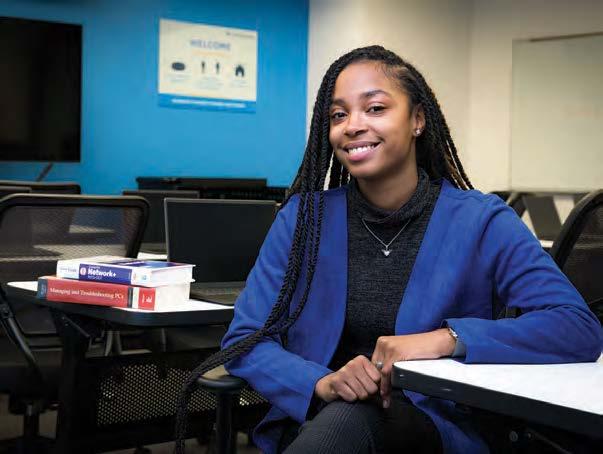 BY KATHERINE DAVIS
BY KATHERINE DAVIS
Walgreens Boots Alliance is betting its future on an unprecedented e ort to reinvent itself as a health care company, a venture of immense scale and complexity. ere’s no playbook for what the Deer eld-based company hopes to achieve. Never before has a retail pharmacy chain transformed into a full- edged provider of medical care. Walgreens’ ambitions threaten to disrupt long-standing U.S. health care delivery structures, a status quo guarded by powerful entrenched interests.
With a series of multibillion-


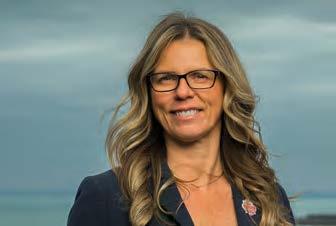
dollar investments and acquisitions, Walgreens is adding an array of services—including home health care and specialty pharmacy—to its existing drugstore network. But the strategy revolves around a bold and risky plan to attach doctor’s o ces to Walgreens stores across the country. Walgreens has opened more than 150 store clinics in partnership with primary care provider VillageMD, with plans to reach 1,000 stores by 2027.
“It is a giant, complicated undertaking,” says Erik Gordon, a professor at the University of




CAREER READINESS
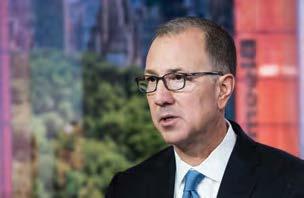
JOHN R. BOEHM CHICAGOBUSINESS.COM | DECEMBER 19, 2022 | $3.50 NASCAR: Racing league is reaching for new fans with its Chicago race. PAGE3 Q&A: Cboe’s Tilly, CME’s Duffy differ sharply on cryptocurrency. PAGE 3
of 2022
the
of the home
PAGE 6
REAL ESTATE A recap
in
billionaire end
market.
The art and science (but mostly art) of cashing out. PAGE 9 NEWSPAPER l VOL. 45, NO. 50 l COPYRIGHT 2022 CRAIN COMMUNICATIONS INC. l ALL RIGHTS RESERVED FORUM AFFORDABLE HOUSING FIND THE COMPLETE SERIES ONLINE ChicagoBusiness.com/CrainsForum AT HOME ON LASALLE A proposed solution to Chicago’s affordable housing crisis is to bring economical units to the historic nancial hub. Is that idea a bridge too far? | PAGE 13 VALERIE CHIANG Readiness programs emerge to shepherd high school and college students into jobs that open a path to nancial stability and wealth-building I PAGE 23
BOOTH INSIGHTS
There’s no playbook for the drugstore chain’s metamorphosis into a health care provider. But there are plenty of challenges.
on Page 30
See WALGREENS
How Illinois Dems could still screw themselves
Two precepts lead Page 1 in my Book of How Politics
Really Works: 1) Never trust a politician, any politician, when they talk about their future electoral plans, because they all lie, and 2) Give any politician or group of politicians enough rope and, be they Democrat or Republican, liberal or conservative, they’ll eventually tie it around their neck and jump.
I kept the rst in mind in watching who led for mayor a few days ago. I’m glad I did, because more than one contender told me one thing and then ended up doing another. As for the validity of the second, look no further than the collapse of Donald Trump and the Republican Party that sold him its soul. After Georgia, unless there is a quick parting of the ways—a realization that, for instance, telling your base not to vote by mail is the message of a loser—the national GOP will join the Illinois GOP in superminority status.
at being said, Precept No. 2
still applies to Illinois Democrats who, thanks to changing demographics, GOP incompetence, J.B. Pritzker’s scal moves and the correct position on some key issues, own all the rope in Illinois politics, including supermajorities in both chambers of the Illinois Legislature.
So, how are they going to tie it and jump?
I suspect it’s the House that’s worth keeping an eye on, both because it’s larger than the Senate with more folks who can stir up mischief and because Speaker Emanuel “Chris” Welch leads the biggest Democratic House majority in state history, the kind of majority that the indicted but shrewd Mike Madigan never wanted because it made enforcing caucus discipline much harder.
Ergo, says one veteran Springeld Dem, keep an eye on pressure to bust the budget and spend money that a state that still has $140 billion in unfunded pension liability really doesn’t have. at pressure
will be even more intense now that House Majority Leader Greg Harris, who had a real talent for getting budgets through, is retiring.
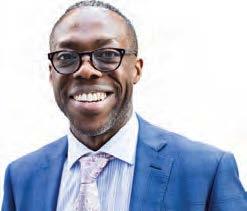
e Democrats, of course, will have to deliver some things simply to satisfy their base. Abortion is the most obvious move, and the D’s will be perfectly within proper bounds if they, for instance, o er up a proposed amendment to include abortion rights in the Illinois Constitution.
Two other issues I’m watching are more problematic: A proposed ban on assault weapons and other steps to control gun use, and a menu of new taxes to help the Chicago Transit Authority, Metra and Pace adjust to the new, post-COVID normal.
On the rst, I and, according to a new poll, most Illinoisans agree that it’s damned foolish to let high school kids run around with military-style ri es that can pump out dozens of rounds every few seconds. Google “Highland
GREG HINZ
ON
POLITICS
Park shooting” if you have doubts. Republicans trying to get back in the game in Illinois politics would be well advised to try to nd a way to put some votes on Rep. Bob Morgan’s bill, if only to help their suburban candidates.
Democrats would be well advised to take their time on this and not appear to rush anything through, a perception that fueled much of the recent debate over the SAFE-T criminal-justice reform bill. And they ought to nd a tweak or a compromise or two to get some GOP votes, because few issues in American politics have the bite this one does.
I’m also sympathetic on CTA/ Metra, et al. But the fact is, the

world has changed and the big transit operators are going to have to change with it. eir business model—people commuting downtown ve days a week—may be irreparably broken, and pushing through a bill to just hike sales taxes or tolls risks irritating voters in what may be tough economic times.
It also would help if the Dems would seriously do something about pensions, and deliver some of that promised but mostly undelivered pledge to limit property tax hikes.
It’ll take a lot for the D’s to blow their majorities. But history says they eventually can, and will. Keep watching.
Why the worst predictions may not materialize

Despite a tumultuous year, the U.S. economy is slowing but isn’t down for the count. Rather, it is undergoing a necessary rebalancing, and an economic contraction would likely be mild. is is because consumers are still in better nancial shape than they were before the pandemic, and the Federal Reserve is waging an aggressive war against in ation to keep things that way.
While the latest wage growth numbers suggest bringing down in ation to the Fed’s target will require further belt-tightening, the strength of private-sector balance sheets indicates there’s light at the end of the tunnel. In ation remains public enemy No. 1, but the peak may already be behind us.
A few recent developments suggest that in ation may nally be on the way down.
A quick glance at the Zillow Home Value Index shows that home values have fallen from their peak this summer. Historically, a decrease in housing wealth has been linked to less consumer spending and less hiring. For that reason, the labor market is also expected to cool.
We are already seeing early signs of that cooldown. According to data from the Job Openings & Labor Turnover Survey, the number of job openings still exceeds the number of job seekers. However, the number of excess job openings has begun to decrease, and hiring has also fallen. According to LinkedIn’s workforce report, hiring is 20.5% lower compared to a year ago.
e Zillow Observed Rent Index, which leads the rent-speci c components of the consumer price

CORRECTION
index, is also falling. If this typical relationship holds, we should expect to see shelter in ation decline. In ation being too high is a threat to sustainable economic growth. It creates economic distortions that lower capital formation, erodes purchasing power and results in less savings and higher long-term interest rates. If high in ation continues to outpace incomes, there is a risk households could run out of savings and a deep contraction would follow. By eroding the value of savings and raising borrowing costs, high in ation hurts everyone, but it disproportionately squeezes lower-income individuals and seniors living on a xed income.
e Fed’s actions aim to realign demand with supply and reduce that risk. e combination of excess demand and inelastic supply suggests that a decline in demand would bring down prices more than economic output, which would be a positive outcome.
e current economic rebalancing began in the housing market, but this moderate price decline we have seen bears little resemblance to what triggered the global nancial crisis. Homeowners are not walking away from homes they can no longer a ord. is time around, most homeowners are in a strong nancial position with low xed mortgage payments and record home equity. Mortgage delinquency rates are at a record low. And while recent layo s at high-pro le rms have occupied headlines and hurt many families, private-sector layo s are still lower than in the 20 years preceding the pandemic.
Rather than a ood of for-sale
Corrected versions of the following profiles in Dec. 12’s Notable Gen X Leaders in Accounting, Consulting and Law can be viewed at ChicagoBusiness.com/notables:
homes from distressed sellers, this slowdown has so far primarily resulted from discouraged buyers taking a step back from the market.
More supply is coming—a recordhigh number of new units are under construction—but with a ordability 25% above historical norms on average, the expected downward price adjustments alone may not be enough to meaningfully improve housing a ordability.
Historically, business activities in the housing market have been a leading indicator of changes in economic growth. ere are major geopolitical and climate risks that
ORPHE DIVOUNGUY ON THE ECONOMY
threaten to disrupt a return to normal, and the decline in housing starts is a sign of trouble for the U.S. economy in 2023. However, if the Fed can e ectively reel in in ation, the economic slowdown could turn out to be a mild adjustment toward
a balanced, sustainable growth path.
2 DECEMBER 19, 2022 • CRAIN’S CHICAGO BUSINESS
Amanda Amert, Roderick Branch, Matthew Petersen, Terra Reynolds, Mitchell Roth and Jack Theis.
#1 IN CUS T OMER SATISF A CTION WITH RETAIL BANKING IN ILLINOIS & BY J.D. PO WER WINTRUS T. C OM/THANKYOU
Wintrust Community Banks received the highest score in Illinois in the J.D. Power 2022 U.S . Retail Banking Satisfaction Study of customers’ satisfaction with their primary bank. Visit jdpower.com/awards for more details. Banking products provided by Wintrust Financial Corp. banks.
Crain’s contributor Orphe Divounguy is a senior economist at ZillowGroup and former chief economist at the Illinois Policy Institute. His views may not re ect those of his employers.
JOHN R. BOEHM
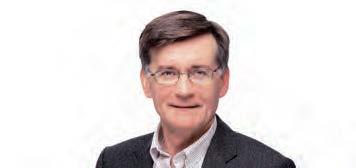
NASCAR bets Chicago will fuel its turnaround
BY DANNY ECKER
After a decade of dwindling relevance, NASCAR is looking to Chicago for a jump-start.
e stock car racing circuit’s street race around Grant Park next July will be its boldest move yet in a broader effort to re-enter the mainstream sports conversation with a younger, more diverse crowd. Instead of staging the rst such event in its 75-year history in a NASCAR stronghold, the sport’s leaders are about to spend more than $50 million—among its largest outlays ever for an event—on a rst-of-its-kind track in the middle of an urban center where it has historically struggled to gain traction. See NASCAR on Page 22
BY STEVE DANIELS
e shocking demise last month of FTX, one of the largest cryptocurrency exchanges in the world, followed by the arrest of founder Sam Bankman-Fried on fraud charges, capped a terrible year for digital currencies and raised questions about their future in the broader nancial services arena.
If they have one, Chicago is home to two institutions— CME Group and Cboe Global Markets—with the expertise and

credibility to help pick up the pieces, along with a potentially lucrative opportunity.
e CEOs of the two exchanges have sharply di ering perspectives on the future of crypto. Correspondingly, they are positioning their companies far di erently in the wake of the FTX debacle.
CME in 2017 listed a bitcoin futures contract and followed later with an ether futures contract. But the exchange hasn’t expanded its o erings since then, and CEO Terry Du y maintains a wait-andsee posture on even the two exist-
ing products as 2023 approaches.
Cboe took a similar toe-in-thewater approach ve years ago but plunged into the industry late last year with a deal to acquire ErisX, an exchange for crypto coins and derivatives, after helping found the rm several years back. e buyout closed in May, just as crypto values were plummeting, which prompted Cboe to write down more than $450 million of the value of the platform. Cboe never disclosed what
JOE CAHILL ON BUSINESS
NAUGHTY
Abbott Laboratories. Abbott gets 2022’s biggest lump of coal, for a multipronged asco arising from safety lapses at its Sturgis, Mich., baby formula plant. Several infants fell ill and two died after consuming formula from the facility. No link to the formula has been shown, but after federal inspectors found bacteria in Sturgis, Abbott closed the plant and recalled formula produced there. e ensuing nationwide shortage caused widespread distress among American families. Abbott’s formula sales plunged, lawsuits rained down and federal o cials moved to boost competition in a market Abbott has dominated for decades.
Peoples Gas. e Chicago gas utility has turned its massive pipe replacement project into an ever-increasing annuity, funded by local customers. Originally projected to cost $2 billion and wrap up by 2030, the replacement of aging gas pipes in Chicago is now on track for an $11 billion price tag and a completion date closer to 2048. at means households already struggling to a ord high gas bills will continue paying extra for the project for decades to come. Mr. Potter would be proud.
The pols behind Illinois’ pot market. Illinois’ legal marijuana market is a case study in good intentions gone awry. Aiming to give communities hurt by the war on drugs a leg up, Spring eld Democrats crafted an elaborate application process and limited the number of pot-selling licenses available. e result has been lawsuits, scant minority participation, slow sales growth and high prices.
Baxter International. Baxter bungled its biggest acquisition ever, the $10.5 billion purchase of hospital bed maker Hillrom. In October, Baxter disclosed a $3.1 billion impairment charge related to the deal, indicating it overpaid by at least that much. e misstep hammered Baxter shares, sparked doubts about CEO Jose Almeida’s growth strategy and could even make Baxter a buyout target.
Illinois unions. Clout-heavy unions cemented Illinois’ reputation as an anti-business state by pushing through a constitutional amendment that hands organized labor even more power. e measure gave Illinois the country’s most pro-union state constitution, and gave businesses another reason to go elsewhere.
NICE
McDonald’s CEO Chris Kempczinski. e burger boss had the guts to speak frankly and publicly about the business impact of crime in Chicago. Speaking to the Economic Club of Chicago, Kempczinski warned of a “growing sense that our city is in crisis,” and said it’s getting harder to recruit executives from out of town to work at McDonald’s Chicago headquarters. But unlike a certain billionaire who left town after railing about crime, Kempczinski wants to solve the problem. He’s moving McDonald’s innovation center downtown from Romeoville, and urging city leaders and business to work together to reduce crime.
Kellogg. Packaged-foods giant Kellogg made a smart move, choosing Chicago as the headquarters for its snacks business as part of a breakup of the Battle Creek, Mich.based company. e biggest and fastest-growing part of Kellogg will t right in among the likes of Mondelez, Kraft Heinz and Conagra, which have made Chicago a hub of the packaged-foods industry. e move also gives Chicago a shot in the arm after high-pro le defections of Boeing, Caterpillar and that billionaire’s hedge fund.
Google. Chicago got another huge boost when Google agreed to buy the ompson Center in the Loop. e tech behemoth’s local workforce of nearly 2,000 is outgrowing its West Loop o ces, and the ompson Center can accommodate thousands more sta ers. e move con rms Chicago remains a growth center for Google, and will bring more people downtown at a time when remote work has depopulated many Loop o ce buildings.
Argonne and Fermi national laboratories. Our national labs continue to draw in federal dollars as they push the frontiers of innovation in key growth areas. anks to Argonne and Fermi, Chicago is on the leading edge of new technologies such as quantum computing and advanced energy storage, which promise to open the doors to new industries.
Companies that did right on Ukraine. e morally correct corporate response to Vladimir Putin’s unprovoked, murderous invasion of Ukraine was to stop doing business in Russia. Here’s to local companies that made the right choice, including McDonald’s, Illinois Tool Works, Motorola Solutions, Molson Coors and Heidrick & Struggles.
CRAIN’S CHICAGO BUSINESS • DECE M BER 19, 2022 3
It’s holiday time, when we decide who’s been naughty and who’s been nice in Chicago business this year.
Naughty or nice? Here’s the verdict on local business in 2022.
“THE CITY OF CHICAGO IS REALLY AN INCUBATOR OF SORTS TO LAUNCH WHAT THE NEXT VERSION OF THE SPORT MIGHT LOOK LIKE.”
Toure Claiborne, marketing executive
The downtown extravaganza planned for next summer is about more than stock car racing I
does the crypto collapse mean for Chicago’s exchanges? Cboe’s Tilly sees ‘opportunity to be the trusted market’ for digital currencies. CME’s Du y sees ‘no use case’ for them.
What
See CRYPTO on Page 22
Julie Giese is president of NASCAR’s Chicago Street Course.
Bears propose stadium-development subsidy plan
BY GREG HINZ
e Chicago Bears are oating in Spring eld the possibility of creating new form of tax subsidy for their pending redevelopment of Arlington Park, one which would give them nancial help but not penalize local school districts as harshly as a conventional tax-increment nancing district.
Under the plan, which has not yet been submitted in writing but has been raised with key legislative players, the Bears would be able to utilize something known as payment in lieu of taxes, or PILT.
PILT originally was developed by the federal government as a means to compensate local units of government for the loss of property taxes due to the existence of tax-exempt federally owned property within their borders. e concept since has spread to payments for state-owned property in some parts of the country and to some private developments, such as solar-energy generation, that are not feasible with normal property taxes.
e Bears’ pitch is in the preliminary stage and is receiving a mixed reception from Spring eld o cials. But because PILT payments can be negotiated rather than being set at a predetermined
rate, and because they can be shared with schools rather than stay with municipalities, they offer more exibility than a conventional TIF district.
NEGOTIABLE PAYMENTS
Under the proposed PILT plan, as explained, the Bears after acquiring the property would no longer pay regular property taxes, which would rise as the value of the property and improvements rose. Instead, they’d pay a negotiated annual amount that would be distributed as per the agreement among schools and other local taxing bodies. at amount presumably would be less than property taxes would, e ectively recompensing the team for some infrastructure and other development costs.
In a statement, the Bears conrm that they continue to explore options to fund the Arlington project.
“As we have mentioned publicly, in order for this project to move forward, we will need to have property tax certainty and infrastructure support,” Scott Hagel, vice president of marketing and communications for the Bears, said in an email. “We continue to do our due diligence on how that can be accomplished but have made no asks at this point.”
e team has said it would fund construction of a new stadium itself but needs help paying costs for a mixed-used development on the remainder of the property.
e Arlington Heights Village Board last month approved a pre-development agreement with the team that envisions the possibility of a TIF district or other public funding.
Asked Dec. 14 if PILT has been discussed, Village Economic Development Director Charles Perkins said he could not go beyond what was included in the pre-development agreement. e agreement commits Arlington Heights to “work in good faith with the Chicago Bears Football Club to explore options for such assistance from other governmental sources, in a manner that
provides net public bene ts for and best serves the interest of, the village and the surrounding community.”
However, sources in both the state Senate and House said the idea has been raised in recent meetings, though no nal wording has been submitted. Among key questions would be whether local o cials could block a proposed PILT, how much it would lower taxes below the level they otherwise would rise to after development, and how disputes among taxing bodies would be resolved.
BROADER SCOPE
Widening PILT to more than the Bears—for instance, adding in clean-energy projects—could boost its legislative appeal.
One area lawmaker,
Ann
Heights, who has been a critic of some TIF spending, said she’s “open to looking at” PILT. However, she added, “My bottom line is that if there is any public support, it’s got to be for di erent public purposes, such as a ordable housing.”
e Bears have projected that their entire proposed complex could generate $1.4 billion in economic impact, spinning o $16 million annually in local tax revenue as well as $60 million per year in tax revenue for Cook County and the state.

e Bears have not yet closed on the track property, but owner Churchill Downs has said it expects that to occur in the rst half of next year.
Horizon CEO set to reap windfall from Amgen buyout
But the future of the drugmaker’s Deer eld presence after the $27.8 billion deal closes is less certain
BY KATHERINE DAVIS
It’s not yet clear what the $27.8 billion sale of Horizon erapeutics to Amgen means for Horizon’s employees or the local biotech industry, but one thing is certain: Horizon CEO Tim Walbert will walk away with a nine- gure payday.
Walbert will collect more than $150 million in cash when his Horizon shares and stock options are converted at the $116.50-pershare buyout price. Horizon lings show that Walbert owns 693,907 Horizon shares, which would be worth $80.8 million in the deal. He also holds options to purchase 742,565 shares at a price of $22.14 each, according to his most recent ownership ling dated June 3 of this year. After deducting the strike price, those shares will convert into $70 million in cash in the buyout.
Walbert stands to get substantial additional sums from equity incentive awards that will also convert to cash at the deal price. e total value of those “performance share units” can’t be calculated because Horizon hasn’t disclosed how many Walbert
currently holds. ose details will likely be revealed in an SEC ling providing more information on the transaction, which is expected to close in the rst half of 2023.
“He’s been compensated very generously,” says Mark Reilly, managing director at Overture Alliance, an executive search and compensation consulting rm. “ ere was certainly an incentive for him to cash out.”
Horizon declined to comment on the gures.
In a statement, the company said Walbert plans to step down from his role after the deal closes, and Amgen CEO Robert Bradway will continue as the top executive of the combined company. According to Horizon’s most recent proxy ling, Walbert would be eligible for about $3.57 million in cash severance and about $4 million in bonuses if he leaves Horizon under certain conditions within 18 months of a sale of the company.
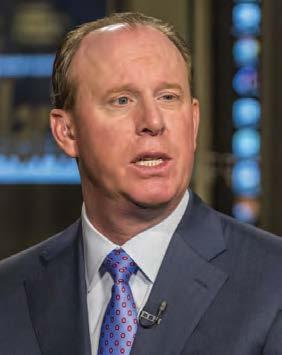
Walbert has led Horizon since 2008, overseeing a series of acquisitions and the development of treatments for rare conditions. Top sellers include a thyroid eye remedy called Tepezza and a gout drug called Krystexxa.
Horizon’s sales have grown to a projected $3.6 billion this year. With o cial headquarters in Dublin, the company employs 2,000 people globally, 700 of them at its operational base in Deer eld.
RESTRUCTURING
Initially approached by Sano , Horizon attracted interest from other large pharmaceutical players before accepting Amgen’s offer. e buyout price is 48% higher than Horizon’s stock market value before it revealed takeover talks, but still below its peak of $119.91 in October 2021. e proposed acquisition throws the future of Horizon’s workforce into doubt. Acquirers often cut jobs at acquired companies as they consolidate operations and reduce overhead.
“With regards to consolidation, I think that’s the promise of mergers, right?” said Dan Lyne, senior vice president in CBRE’s global life sciences practice.
Horizon hasn’t directly addressed the question of layo s in Deer eld or elsewhere. A “Frequently Asked Questions” document circulated to employees in-
cludes a query about the possibility of layo s, but says only that none are expected before the deal closes.
Amgen said it will consider consolidating some or all of Horizon’s o ces into Amgen’s global headquarters in ousand Oaks, Calif. Amgen also said there will be some operational and administrative restructuring of Horizon sta after the deal closes, but noted that it does not intend to make any “material change” to the sta and hasn’t yet made any decisions about the kinds of roles or locations that could be a ected if there are changes.
With control of Horizon moving to California, the Chicago region will have one less company in the life science sector e ectively headquartered here. Decisions a ecting the business will now be made by executives thousands of miles away. Even so, experts say the deal could be positive for the local biotech, pharma and biosciences industries.
“It’s completely a win for the community,” says John Conrad, CEO of the Illinois Biotechnology Innovation Organization. “ ey grew the company in Chicago. I think a lot of people probably
thought that they couldn’t do that, but they obviously built it into a multibillion-dollar company with research arms across the country and global sales.”
Conrad says the riches reaped by Walbert and his lieutenants could eventually seed new biotech startups in the area. He points out that Je Aronin launched Paragon Biosciences after selling Ovation to Lundbeck in 2009 for $900 million, and Sean Nolan started Jaguar Gene erapy after selling AveXis to Novartis for $8.7 billion in 2018, ventures largely made possible through fortunes amassed from the buyouts.
4 DECEMBER 19, 2022 • CRAIN’S CHICAGO BUSINESS
The organization is pitching o cials in Spring eld on nancing that would help them but not penalize local school districts as harshly as a conventional TIF
state Sen.
Gillespie, D-Arlington
Tim Walbert
A rendering of the proposed Arlington Heights complex.
BLOOMBERG
HART HOWERTON / CHICAGO BEARS
Happier holidays are within your grasp.
Spend and save smarter, all in one place. With impressive digital tools from Bank of America, you’ve got more power than you think.
Sometimes, the most wonderful time of the year can feel anything but wonderful. So if you need help with your business, financial future or just making paycheckto-paycheck go further — we’re here. With personalized products, simple solutions and experts in Chicago, you can keep life moving the way you need it to.
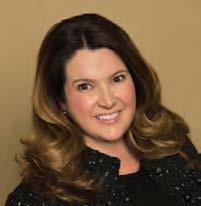


Go to bankofamerica.com/chicago to learn more

What would you like the power to do?®

Bank of America, N.A. Member FDIC. Equal Credit Opportunity Lender © 2022 Bank of America Corporation. All rights reserved.
Rita S ola Co ok
Presid en t, B an k of A merica C hica go
A year of billionaires’ real estate moves
Gri n,
I BY DENNIS RODKIN
The super-rich buy and sell homes like everyone else. Their deals just have more zeroes in them.
Here’s a look back at 2022’s noteworthy housing deals involving billionaires.
In January, two members of the Reyes family, the billionaire beverage clan whose $31.5 billion privately held company Reyes Holdings is based in Rosemont, bought the grand Lake Geneva estate left behind by the late nancier Richard Driehaus.

J. Christopher Reyes and Anne Reyes paid $36 million for the 40-acre estate, which includes a 13-bedroom Colonial mansion built in the early 1900s and over 620 feet of frontage on Geneva Lake. The couple, whose worth Forbes pegs at $7 billion, also have homes in Lake Forest and Jupiter Island, Fla.
When a condo at No. 9 Walton sold in April for $17.4 million, the buyers were not disclosed.
e Chicago Tribune later learned they were Steve and Nancy Crown. ey are members of the Crown dynasty, whose total wealth Forbes puts at $10.2 billion from their ownership stakes in General Dynamics, New York’s Rockefeller Center, the Chicago Bulls and the New York Yankees. e couple also own a Winnetka mansion that formerly belonged to Steve’s parents, Lester and Renee.
Jennifer Pritzker, a cousin of the governor and, like him, a member of the wealthy Pritzker dynasty, in April sold her fourth Evanston property. Estimated to be worth $1.9 billion, Pritzker, the world’s only known transgender billionaire, owned the four homes through her rm Tawani Enterprises. Two had operated as bedand-breakfasts, but Tawani did not disclose the uses of the other two.
David “Duke” Reyes is a younger brother of J. Christopher Reyes and Jude Reyes, who are co-chairmen of the family rm. Duke, who’s worth $1.2 billion, is CEO. It’s not clear whether Duke and Pamela Reyes maintain a Chicago-area residence. e last time their names appeared in public real estate records was 2013, when they sold an East Lake Shore Drive condominium.
In June, the founder of computer retailer CDW sold a lakefront mansion in Highland Park for $3.53 million. Michael Krasny, whose worth Forbes puts at $1.3 billion and who has a $4.5 million condo on Michigan Avenue, initially put the home on the market in September 2020 at almost $2 million more than it eventually sold for.

e 2.6-acre property has 400 feet of Lake Michigan shoreline, a swimming pool and a 13,000-square-foot house.
LAKEFRONT BATTLE
a fourth home, contiguous with two others they owned. Later, a pair of Winnetka residents pushed the town to use eminent domain to seize the Ishbias’ parcel that is between two parks.
The Winnetka Village Board, which is a separate governmental entity from the park district, this month approved the Ishbias’ application to combine three lots into one legal parcel.
More developments in this story should come in 2023, as the park district and the Ishbias haggle over the piece between two parks, and as plans for the Ishbias’ proposed house emerge.
Also in June, Citadel chief Ken Griffin announced he would move both his company and his family to Florida full time.
e next month, Gri n launched a sell-o of his portfolio of Gold Coast condos, putting four condominiums in three buildings up for sale. e sum of the asking prices is $54.5 million. at’s not all he may eventually o er; Gri n is known to own at least two more condos in Chicago.

IN COMING MONTHS, LOOK FOR TWO ADDITIONAL SALES AND POSSIBLY MORE OF GRIFFIN’S CHICAGO PROPERTIES HITTING THE MARKET. HE IS ALSO BUILDING THE FIRST MANSION, A HOUSE FOR HIS MOM, ON HIS 25 ACRES IN PALM BEACH.

In the sello , the four properties went for a combined $7.8 million. At least two were sold at a loss, but because property records aren’t clear on what Tawani paid for one of the four, it’s not possible to say whether the sello was pro table or not. Pritzker also owns a Winnetka mansion.
In May, two more members of the Reyes clan, Duke and Pamela, sold a Florida mansion for $21 million. at was 82% more than they paid for it four years earlier.
Justin and Kristen Ishbia, who had purchased three lakefront Winnetka properties for nearly $24 million in 2020 and 2021, ran into a roadblock in June. ey’d agreed on a land swap with the Winnetka Park District that would give one of the Ishbias’ parcels to the park district in exchange for a piece of park land that is next to their other two parcels. But that angered local residents, which led to the park district withdrawing from state and federal applications for beach improvements.
Justin Ishbia is the head of Shore Capital Partners, a private-equity rm, and a board member in a Michigan mortgage rm founded by his father and now run by his brother, Mat. Forbes says he’s worth $2.4 billion. e Ishbias also have a $12.6 million Lincoln Park mansion.
Over the next few months, the situation continued to unfold.
e Ishbias paid $16 million for
By December, the fourpart selloff was half-finished, with one unit sold at a loss of over $3 million and another under contract to a buyer.
In coming months, look for two additional sales and possibly more of Gri n’s Chicago properties hitting the market. Gri n has also begun building the rst mansion, a house for his mom, on his 25 acres in Palm Beach.
Forbes estimates Griffin is worth $31.7 billion.
In August, ex-spouses Bill Gates and Melinda French Gates put up for sale the Hyde Park house they had purchased for their son Rory to live in while he was enrolled at the University of Chicago. ey listed it at $1.55 million. Buyers put the house under contract nine days later, and the sale closed in mid-September at $1.5 million.
Bill Gates is reported to be worth more than $105 billion. Melinda French Gates’ wealth is estimated at $6.9 billion.

6 DECEMBER 19, 2022 • CRAIN’S CHICAGO BUSINESS
Ken
Bill Gates, Jennifer Pritzker and other super-rich homeowners made some splashy deals in Chicago and the suburbs in 2022. Here’s a look at the biggest.
Inside the Lake Geneva estate of late nancier Richard Driehaus.
No. 9 Walton
GENEVA LAKEFRONT REALTY ENGEL & VOELKERS CHICAGO NORTH
GENEVA LAKEFRONT REALTY
COMPASS
Billionaire Jennifer Pritzker sold this Evanston mansion in April.
SHORE
GOLD COAST REALTY CHICAGO
Duke and Pamela Reyes sold this Palm Beach, Fla., home in May for $21 million.
Late nancier Richard Driehaus’ Lake Geneva estate was bought by J. Christopher Reyes and Anne Reyes.





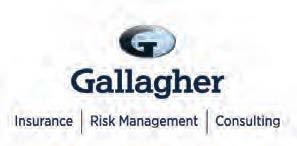


you to the
www.soill .org BIOSCIENCES INC.
Thank
2022 Special Olympics Illinois corporate partners, donors, volunteers, and coaches for providing opportunities for
2022 Statewide Sponsors
Lettuce reveals restaurants for St. Regis Chicago
The rst dining room is expected to open next spring in tandem with the high-end hotel
BY ALLY MAROTTI
Lettuce Entertain You announced the names of its two restaurants that will open next year in the St. Regis Chicago.

e rst restaurant, Miru, is expected to open next spring in tandem with the hotel, which has experienced delays. “Miru” is the Japanese verb for “view,” and it will have two terraces and an 11th- oor dining room that overlook the Chicago River and Navy Pier.
e Japanese restaurant from Chef Hisanobu Osaka will offer sushi, sashimi, hot pots and more. Osaka has worked at Michelin-starred Daniel in New York, served as private chef for a Japanese diplomat in New Orleans, and worked on menu development at other Lettuce restaurants including Wow Bao and Aba.
Overseeing both restaurants’ beverage programs will be Diane Corcoran, a Lettuce mixology alum. Additionally, Juan Gutierrez—previously of Four Seasons Chicago and a winner of Net ix’s “School of Chocolate”—will be the executive pastry chef.
Lettuce rst teased the restaurant concepts that would be going into the St. Regis this fall. Lettuce took over dining operations in the St. Regis earlier this year, after a previous deal between developer Magellan Development Group and Alinea Group fell through. at change contributed to a delay in the hotel’s debut.
e high-end hotel has been highly anticipated. It will occupy 11 lower oors of the Lake Shore East tower. At 101 stories, the Jeanne Gang-designed tower is the third-tallest building in the city. Residents started moving into the residential portion of the building in late 2020.
U of I plans weed research center at Discovery Partners Institute
DPI is teaming up with the city and state on marijuana research to capitalize on Chicago’s critical mass in the burgeoning cannabis industry
BY JOHN PLETZ
Discovery Partners Institute, the University of Illinois research center underway in the South Loop, has high hopes to launch a marijuana research facility.
DPI has begun a search for an executive director and researchers, and it has support from the city of Chicago and the state of Illinois. But it doesn’t yet have funding commitments from either one for a project that likely will need tens of millions to become a reality.
e cannabis research institute is the rst signi cant e ort by the city and state to build on Chicago’s critical mass in the marijuana industry. e city is home to several of the largest U.S. marijuana companies—including Cresco Labs, Green umb Industries, Verano and PharmaCann—which employ thousands of workers. Since legalizing recreational marijuana three years ago, sales have grown to about $1.5 billion.
e University of Illinois sees opportunities to draw on its strengths in agriculture, genomics and medicine to study topics ranging from marijuana production to the health impacts of cannabis.
“It’s a natural for us to be a gathering point,” says Bill Jackson, executive director of DPI. “It’s an industry that Illinois wants to win
in. It’s an industry that’s going to be sizable.”
Because cannabis is federally illegal, there hasn’t been as much research as in other elds. Universities are worried about putting their federal research grants for other projects at risk by working with cannabis. But recent federal legislation loosens some of the restrictions, making it easier for researchers to get approval to work with cannabis.
A handful of universities have marijuana research programs, including the University of Mississippi, UCLA and the University of California San Diego.
“Our intent is to be the best in that space,” Jackson says.
DPI is a research center for the
Saks discount chain to return to State Street
Saks O 5th is reopening a store that it closed in 2019, before the pandemic devastated retail in the Loop
BY ALBY GALLUN
e second restaurant, Tre Dita, is slated to open in the second half of 2023. “Tre Dita” is Italian for “three ngers,” and elicits the thickness of the Bistecca alla Fiorentina the restaurant is set to serve, according to a news release from Lettuce.
e restaurant group is working with award-winning Chef Evan Funke on the second- oor restaurant. e Los Angeles chef runs Roman-inspired
Beyond just the restaurant operator, the tower at 363 E. Wacker Drive has seen its share of changes since Magellan broke ground in 2016. e project was called Wanda Vista Tower then, but Chinese conglomerate Wanda Group bowed out and sold its 90% stake in the development to Magellan and partners Goldman Sachs and J.P. Morgan. e “Vista” name was later dropped.
e condo building was pitched as a place rich in amenities and services, and such changes matter to prospective buyers in the building. A twooor condo on the 71st and 72nd oors sold for $20.56 million earlier this year.
After a three-year hiatus, Saks O 5th is returning to State Street in the Loop, welcome news for a key Chicago retail strip awash in vacant space.
e discount women’s apparel retailer said it’s reopening a store at 6 S. State St. and another one in the NewCity shopping center on the Near North Side after closing them in 2019. e move will lower the retail vacancy rate on State Street, which has soared since the onset of the COVID-19 pandemic due to a wave of store closings.
Saks O 5th was among the bigger retail tenants on the Loop shopping strip, opening its 23,500-square-foot store there in 2016. ough the store has been closed since 2019, the chain, a unit of Toronto-based Hudson’s Bay, still controls the space through its original long-term lease with the owner of the prop-

erty, a joint venture between New York-based Madison Capital and Bethesda, Md.-based ASB Capital Management.
State Street needs many more retailers to recover from a pandemic that has been devastating to the Loop retail real estate market, and to State Street in particular. Chains including Urban Outtters, DSW and New York & Co. have closed stores there, and Old Navy decided not to renew a lease for its store at State and Randolph streets that expires at the end of the month.
ough a few retailers, including Five Below and shoe merchant JD Sports—Saks’ neighbor to the south—have opened stores on State Street, the Central Loop’s retail vacancy rate was 23.1% at the end of 2021, down from 26.1% in mid-2021 but still well above 14.7% in 2019, according to Chicago retail brokerage Stone Real Estate. But more retailers are seriously
U of I system that will be built in the South Loop, which still is in the formative stages. Construction on its facilities is scheduled to begin in 2024, but it has o ces downtown.

e idea of a housing cannabis research facility at DPI has been in discussion for about nine months, but funding is still up in the air.
“It’s not a wish and a prayer,” Jackson says. “It will happen. We’ve had long conversations with the city and the state.”
Jackson didn’t specify how much money will be required but says “$50 million wouldn’t be a bad target. Predominantly, funding will come from grants or independent groups.”
6 S. State St.
“It’s a sign that things are coming back,” he said.
Representatives of Madison Capital and ASB did not respond to requests for comment. e rms in 2014 paid $60 million for the storefront and two immediately to the south, one occupied by JD Sports and another, formerly occupied by Urban Out tters, that’s vacant.
Saks O 5th said it plans to reopen the State Street store and the one at NewCity, which totals 40,000 square feet, in the spring.
e chain already operates stores in Northbrook, Rosemont and Aurora.
8 DECEMBER 19, 2022 • CRAIN’S CHICAGO BUSINESS
Mother Wolf in California.
shopping for space on the street, said retail broker Luke Molloy, senior vice president in the Chicago o ce of CBRE. He’s encouraged by the return of Saks.
A rendering of Miru at the St. Regis Chicago.
GOOGLE
DISCOVERY PARTNERS INSTITUTE
ROCKWELL GROUP
An architect’s rendering of the headquarters building.
LETTUCE TOOK OVER DINING OPERATIONS IN THE ST. REGIS EARLIER THIS YEAR AFTER A PREVIOUS DEAL FELL THROUGH.
The art and science (but mostly art) of cashing out
One of the most di cult questions entrepreneurs face is how and when to sell a business. While many companies worry about selling too soon and realizing too little of the eventual enterprise value, few worry about selling too late and, in the worst case, missing the chance to sell altogether.
Every business is di erent, and some o ers of acquisition should be refused outright. But what considerations help most when valuing an early-stage business?
As the seller, the rst thing to consider is that your calculation of your business’s value may not be the same as the acquirer’s. Two common ways to value a business earlier on are discounted cash ow, or DCF, and multiples, in part because peer evaluation ( nding comparable rms) may prove dicult when the business is in a startup stage or hasn’t yet settled into an ecosystem of direct competitors.
However, these approaches don’t always work. Why?
DCF, an e ort to calculate the present value of future cash generated by a business, can be hard to use if a business is growing fast or in an industry experiencing uctuating margins. Modifying or “tuning” a DCF model often leads
to overcomplexity or a high number of assumptions—yet reducing the number of assumptions makes the model more dependent individually on each of a small number of assumptions, which is hardly a desirable simpli cation.
So is a multiple of current revenue the better approach to valuation? Perhaps.
But even mature companies in well-understood businesses may vary substantially in priceto-earnings ratio (or price-to-netrevenue, etc.). Take, for instance, Best Buy and Circuit City in 2004, when both were mature, nationwide, well-known retailers. Best Buy at $47 per share represented a 13 times earnings multiple, while Circuit City at about $13.50 per share represented a 22 times earnings multiple (the S&P 500’s average at the time was about 15.5 times earnings).
Looking more deeply, we see structural di erences, like Circuit City having a great deal of cash on hand. But entrepreneurs understandably worry their enterprises will be undervalued or valued on a whim rather than carefully appraised.
is uncertainty leads many to say: “I’ll wait until the business stabilizes and we have XX months
of proven revenues and can negotiate more robustly with counterparties.”


e problem is that turbulence never subsides, and greater certainty may actually reduce valuations by quelling otherwise-imagined upside. It's analogous to the old venture-capital saying that it’s easier to raise nancing for a com-
pany with $0 in revenue than one with $1 in revenue. What to do?
Don’t be afraid to negotiate using di erent metrics from the other side or using metrics peculiar to your industry. Educate the acquirer about how to value the enterprise.
Resist being seduced by the complexity and claimed precision of the acquirer’s valuation models. Be prepared to rebut their assumptions, especially around growth scale and rate.
Re ect on whether the business
is worth much less without you and what the acquirer might need to o er to retain you. ey very well may want you to stick around Be honest about the value of liquidity to you personally. If the business is a huge chunk of your personal wealth, you may reasonably want to take cash o the table. Selling a company slightly before it is “fully ripe” is a common fear, but bear in mind that all ripe fruit is soon spoiled. While there is no “right” time to do a deal, it is di cult to sell when people no longer want to buy.

CRAIN’S CHICAGO BUSINESS • DECE M BER 19, 2022 9 ChicagoBusiness.com/CareerCente r Connecting Talent with Opportunity. Fr om to p ta lent toto p em pl oyer s, Crain’s Career Center is the next step in yo urhiring process or job se arch . Get started to da y
Advice for small businesses and entrepreneurs in partnership with the University of Chicago Booth School of Business.
GETTY IMAGES
Karl T. Muth is a consultant who teaches new venture strategy at Chicago Booth and studies decision-making and negotiation.
The Bears’ subsidy play is a nonstarter
The Chicago Bears stuck a giant foam nger in the air this week in hopes of nding out how lawmakers and taxpayers would feel about contributing public money to their Arlington Heights stadium plans.
What they’re nding is that, even if it’s gussied up as a newfangled cousin of a conventional tax-increment nancing district, the idea is going over about as well as a botched Cody Parkey eld goal.
And that’s as it should be. What the McCaskey clan and the Bears organization are asking for in Spring eld is nothing short of a backdoor public subsidy of their stadium campus proposal. As Crain’s Greg Hinz was rst to report—so early to report, in fact, that some public o cials only learned of the idea when reached for comment—the Bears are shopping for a relatively obscure form of public support and are hoping some of the ne points will make the deal more palatable to taxing bodies like local schools, park districts and libraries.

Under the plan, the Bears would utilize something known as payment in lieu of taxes, or PILT.
PILTs are a tool originally created by the federal government to compensate local governments for the loss of property taxes because of tax-exempt federal property within their borders. e concept since has spread to payments for state-owned property in some parts of the country and to some private developments, such as solar-energy generation, that are not feasible to build with normal property taxes. But because PILT payments can be negotiated rather than being set at a predetermined rate—as TIF subsidies usually are—and because the revenue from these payments
can be shared with schools rather than stay with municipalities, they o er more exibility than a conventional TIF district. Here’s what the Bears want: After acquiring the Arlington property, the organization would no longer pay regular property taxes, which would rise as the value of the property and improvements rose. Instead, they’d pay a negotiated annual amount that would be distributed as per the agreement among schools and other local taxing bodies. at amount presumably would be less than property taxes would be, e ectively compensating the team for some infrastructure and other de-
velopment costs. But the payout to schools and other taxing bodies would, in theory, be more than they would get under a conventional TIF plan.
e village of Arlington Heights has agreed to consider helping to defray some infrastructure expenditures that arguably could bene t the entire community and not just the Bears. e PILT idea now circulating in the capital, however, is a signi cant step beyond that commitment. And it’s one that Arlington Heights and Spring eld lawmakers would be right to reject. e Bears ownership group has next to no leverage on this point. Leave Chicago? It’s hard to imag-
YOUR VIEW
ine the National Football League would abandon this market for long.
To use a PILT for building a stadium campus for a wealthy NFL franchise would be stretching the original purpose of this taxing tool past the breaking point—and would open the oodgates for other team owners looking for a similar handout.
Speaking of other team owners: e Ricketts family has nanced its Wrigley Field revamp without taxpayer help. Why can’t the McCaskeys do the same? e era of pro sports teams shaking down municipalities for public nancing is over—or, at the very least, it should be, and Arlington Heights should declare it thus. e village is a thriving, middle-class suburb with a lively downtown, two Metra lines, quick access to O’Hare, blue-ribbon schools, a park district that sports two golf courses as well as six swimming pool complexes and an indoor tennis center, one of the best libraries in the country and property values that are on the rise. In short, it’s not a community struggling to attract investment and development. ere is precious little reason this village should hand over a slice of its tax income to fund a stadium campus where fewer than 10 regularseason games will be played a year.
e Arlington International Racecourse property represents a unique opportunity to redevelop a relatively close-in parcel of suburban land that’s roughly the size of Chicago’s Loop—with or without a football stadium. If the Bears can’t gure out how to make the most of that opportunity on their own—or with the help of a deep-pocketed partner—then perhaps they should stand aside and allow someone else to draw up a game plan instead.
Let’s see a public safety New Year’s resolution
With the end of 2022 in sight, many Chicagoans’ thoughts naturally turn to their goals for the new year.
e Civic Federation suggests our local government leaders make some New Year’s resolutions of their own—starting with the city of Chicago and its plans for improving public safety.
As Chicago continues to emerge from the coronavirus pandemic and celebrates the holiday season with skating in Millennium Park and the CTA Holiday Train, the city’s improved nances are also worth celebrating. Less worth celebrating, however, is the city’s progress toward public safety and police reform.
e statistics remain deeply unsettling: Crime in Chicago is up 40% in 2022 over 2021 and 2020, per the Chicago Police Department’s data. While murders and shoot-
ings slightly decreased compared with 2019, violence levels in Chicago remain unacceptably high. We pay a tremendous price for this: the unnecessary loss of lives, a sense of reduced safety among residents and visitors, and the toll that heightened crime takes on the vitality of our city and businesses. is holiday season, public safety improvements are at the top of the business community’s wish list for the city’s future.
e Chicago Police Department has for four years been under a federal consent decree. is should be a strong road map to guide our city policing forward. However, progress toward implementing the policies and reforms spelled out in the consent decree—and importantly, communication of that progress to the public—has been insu cient. e department also continues to face criticism for being slow to imple-
ment constitutional policing practices, as expressed at a Nov. 29 public hearing on the consent decree.
In 2023 and beyond, we need to see and hear more about the city’s e orts and results.
As it stands, public statements from the police too often frame the department’s progress toward compliance with the consent decree in terms of percentages, which do not improve the public’s understanding of what the city is doing to achieve outcomes. We urge the city of Chicago to better communicate how consent decree requirements are informing its public safety strategy. City leaders need to demonstrate that the city is actively working to fundamentally reshape the way it approaches police services, with the dual goal of improving policing and reducing violence.
e Civic Federation joins calls for a cultural transformation of the Chicago Police Department into a modern, constitutional,
Write us: Crain’s welcomes responses from readers. Letters should be as brief as possible and may be edited.Send letters to Crain’s Chicago Business, 130 E. Randolph St., Suite 3200, Chicago, IL 60601, or email us at letters@chicagobusiness.com. Please include your full name, the city from which you’re writing and a phone number for fact-checking purposes.

data-driven department. is means: embracing the use of data in decision-making and ensuring that all city and county stakeholders are working from the same set of facts; welcoming evaluation from outside experts; fully embracing a community policing philosophy; and putting su cient resources, sta and processes in place to ensure successful implementation of the consent decree.
In line with a cultural transformation is an improvement in transparency and accountability. With one of the highest numbers of police per capita in the nation and a budget of nearly $2 billion, the Chicago Police Department must be more e ective and transparent. e Civic Federation urges the department to publish the basis on which o cer sta ng allocations are made and conduct a data-driven re-evaluation of its use of resources and sta .
Of additional concern to the Civic Federation is that we have little sense of how much
Sound o : Send a column for the Opinion page to editor@ chicagobusiness.com. Please include a phone number for veri cation purposes, and limit submissions to 425 words or fewer.
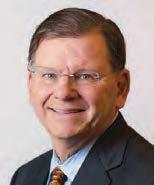
10 DECEMBER 19, 2022 • CRAIN’S CHICAGO BUSINESS
EDITORIAL
HART HOWERTON/CHICAGO BEARS
Laurence Msall is president of the Civic Federation.
A rendering of the propsed Bears stadium campus in Arlington Heights.
the full implementation of the consent decree will cost the city. What we do know is that the cost of not achieving transformation of the police department will be much higher—far exceeding the hundreds of millions of dollars that taxpayers have already paid in damages for unconstitutional policing and harm to Chicago citizens. We hope to see the department make public its progress toward consent decree requirements, including training, unity of command and e ective sta ng ratios. Similar sentiments have been raised by the new Community Commission for Public Safety & Accountability.
e public also needs to know how many police o cers and non-sworn personnel the department actually needs. We know it
CRAIN’S
President/CEO KC Crain
Group publisher/executive editor Jim Kirk
Editor Ann Dwyer
Creative
Director
Assistant managing editor/audience engagement Aly Brumback
Assistant managing editor/columnist Joe Cahill
Assistant
Assistant
Deputy
Account
Keith E. Crain Chairman
Mary Kay Crain Vice chairman
KC Crain President/CEO
Chris Crain Senior executive vice president Robert Recchia Chief nancial o cer

Veebha Mehta Chief marketing o cer
G.D. Crain Jr. Founder (1885-1973)
Mrs. G.D. Crain Jr. Chairman (1911-1996)
For subscription information and delivery concerns please email customerservice@ chicagobusiness.com or call 877-812-1590 (in the U.S. and Canada) or 313-446-0450 (all other locations).

is working to address recruitment, training and retention amid hiring challenges in the tight labor market, and we recognize that police hiring gures have improved since the height of the pandemic. However, we still don’t know where we need to be. e Civic Federation urges the city to communicate more e ectively what it is doing to secure quality sworn and civilian sta , and how those e orts are helping the department to reach sta ng goals.
e Civic Federation further recommends a much greater investment in safety on public transit. We remain concerned about safety, cleanliness and reliability on the Chicago Transit Authority. Ridership has not recovered to pre-pandemic levels, and the city
cannot a ord to continue to lose riders based on the perception that the CTA is unsafe. Chicago’s public transit system is critical to ensuring the city’s recovery post-pandemic and upholding its global reputation. We urge the city to work with the CTA on more e ective security measures and solutions to address the root causes of disruptive behavior.
Finally, the city should continue its longterm investments in the Invest South/West initiative and violence prevention programs, which show promise but require signi cant additional nancial resources to bring these e orts to scale and secure their continuation.
Lest someone mistake me for Ebenezer Scrooge, let me be clear that as the ball

drops on New Year’s Eve and Chicagoans make plans to start saving or exercising more in 2023, they still have good reason to feel hopeful about the future of our city. It is in better nancial shape, as recognized by bond rating agencies, and was able to include a sizable supplemental payment to its pension fund in its scal 2023 budget, thanks to better-than-expected revenue performance.
In order to stick to a resolution, most experts say it should be measurable and achievable. is, in essence, is what we are looking for from Chicago leaders in their plans for the consent decree and police modernization. Let’s hear, in detail, what those resolutions are.
CRAIN’S CHICAGO BUSINESS • DECE M BER 19, 2022 11
director Thomas J. Linden
of audience and engagement
Elizabeth Couch
managing editor/digital content creation Marcus Gilmer
managing editor/digital Ann R. Weiler Assistant managing editor/news features Cassandra West
digital editor Todd J. Behme
Deputy digital editor/audience and social media Robert Garcia
Digital design editor Jason McGregor Associate creative director Karen Freese Zane Art director Joanna Metzger Copy chief Scott Williams Copy editor Tanya Meyer Contributing editor Jan Parr Political columnist Greg Hinz Senior reporters Steve Daniels, Alby Gallun, John Pletz Reporters Katherine Davis, Brandon Dupré, Danny Ecker, Jack Grieve, Corli Jay, Justin Laurence, Ally Marotti, Dennis Rodkin, Steven R. Strahler
Contributing photographer John R. Boehm Researcher Sophie H. Rodgers
Senior vice president of sales Susan Jacobs Vice president, product Kevin Skaggs Sales director Sarah Chow
Events manager/account executive Christine Rozmanich Marketing manager Cody Smith Production manager David Adair Events specialist Kaari Kafer Custom content coordinators Ashley Maahs, Allison Russotto
executives Claudia Hippel, Bridget Sevcik, Laura Warren Sales administration manager Brittany Brown
People on the Move manager Debora Stein Digital designer Christine Balch
CHICAGO BUSINESS YOUR VIEW Continued
Access the ci ty’s leading business news in print, online or on any mobile device with our new app, now available for download for free with your subscription! Visit chicagobusiness.com today or find us in the app store GET MORE
PEOPLE ON THE MOVE
BANKING
First Bank Chicago, Northbrook
First Bank Chicago proudly announces the promotion of Marcela Melendez to Chief Lending Of cer, Lease Finance Group. In this executive role, she leads a diverse team of professionals that oversee the Lease Finance portfolio which includes business development, administration, credit, and documentation. With 30 years of banking and leasing expertise, Marcela is a seasoned banker who has contributed to various bank-wide initiatives and process improvements. She joined the First Bank team in 2019.


BANKING
First Bank Chicago, Northbrook
First Bank Chicago proudly announces the promotion of Ryan Liebgott to Vice President, Credit Manager for the Lease Finance Group. In this new role, Ryan will oversee and lead the credit team in the Lease Finance Group. Ryan and his team are responsible for underwriting and portfolio management for fortune 1000 customers within the Lease Finance Group. Ryan has over 15 years of underwriting experience in commercial and industrial leasing. He joined the First Bank Chicago team in 2019.
BANKING
First Bank Chicago, Northbrook
First Bank Chicago proudly announces the promotion of Patrick Niday to Vice President, Lease Finance Group. Patrick is responsible for supporting the Bank’s growth strategy by enhancing Lease Client relationships while also developing and building new customer contacts in the marketplace. He also oversees the Lease Finance Group’s business monthly and annual development reporting. Patrick has over 15 years banking and leasing expertise and joined the First Bank Chicago team in 2019.

BANKING
First Bank Chicago, Northbrook




First Bank Chicago proudly announces the promotion of Sam Jaramillo to Lease Documentation Of cer. He is responsible for managing the documentation of the leasing portfolio & funding of all lease transactions. This includes legal review of new lease originations and maintaining proper documentation for the lease portfolio including Latin American fundings. He works closely with our Lessor relationships and internally interacts with many areas of the Bank. Sam joined the First Bank team in 2019.

ACCOUNTING
ORBA, Chicago

ORBA, one of Chicago’s largest public accounting rms, welcomes Sandy Burhans as the rm’s Sports and Entertainment Group Leader. With more than 20 years of experience, Sandy is a trusted advisor who simpli es her clients’ tax preparation through the complicated “jock tax” spider web. Previously, she spent two decades with a top sports agency where she handled many client relationships spanning from the athletes’ rookie year to veteran status to retirement.
CONSTRUCTION
AECOM Hunt, Chicago
Jeremy Andersen has joined AECOM Hunt’s Chicago of ce as Project Executive. Spanning more than two decades, Jeremy’s work has included extensive projects throughout Chicago, largely focused in the aviation and high-rise, luxury, and mixed-use residential markets. Prior to AECOM Hunt, Jeremy served as Senior Superintendent at Leadlease. In his new role, he will provide eld and preconstruction expertise on major regional projects.
FINANCIAL SERVICES
Baird, Chicago
To place your listing, visit www.chicagobusiness.com/peoplemoves or, for more information, contact Debora Stein at 917.226.5470 / dstein@crain.com
INSURANCE
Newfront, Chicago
Chris Morse joins Baird as a Managing Director and Public Finance Banker. He brings over 29 years of experience in investment banking and corporate nance. In his new role, Morse will help develop nancing plans that use clients’ credit strengths to execute institutionally critical nancings. Morse received his Bachelor of Science from Louisiana Tech University and served in the United States Marine Corps.
FINANCIAL SERVICES
Baird, Chicago
Steve Simpson, CFA®, joins Baird as a Managing Director and Public Finance Associate Banker. He brings more than 30 years of experience to the business, having specialized in municipal nance, business development, managing complex transactions, investment banking, and capital services. In his new role, Simpson will help develop nancing plans that use clients’ credit strengths to execute institutionally critical nancings. Simpson holds a BA in Political Economy from Williams College.
FINANCIAL SERVICES

Baird, Chicago
CONSTRUCTION
Pepper Construction, Chicago

Pepper Construction has promoted Ashlie Stapleton to Director of Diversity, Equity and Inclusion. Ashlie has operational experience in construction project management, a strong understanding of Pepper’s culture, a passion for advancing the industry and a deep commitment to improve diversity, equity and inclusion in the community. Ashlie joined Pepper in 2018, holds a Bachelor of Civil Engineering from the University of Illinois and has been a key contributor to Pepper’s DE&I initiatives.
EDUCATION
People’s Music School, Chicago
Miriam Goldberg Owens has been appointed President & Chief Executive Of cer of The People’s Music School. Owens has served on the organization’s leadership team since August 2021, joining as Chief Operating Of cer. She became Chief of Development and Operations in April 2022, expanding the organization’s fundraising footprint while driving operational improvements. Owens enters the role with a wealth of senior leadership experience in the social and private sectors.
Carlo Fitti joins Baird as a Director and Public Finance Associate Banker. He brings more than 20 years of securities experience to the business. In his new role, Fitti will help develop nancing plans that use clients’ credit strengths to execute institutionally critical nancings. Fitti is a graduate of Swarthmore College, holding a BA in Economics.
HEALTH CARE

Compass Health Center and Compass Virtual, Chicago
Compass Health Center has named Justine Mitchell as its new Senior Vice President of Compass Virtual. Before becoming SVP of Compass Virtual, Mitchell served as one of the founding members of Illinois-based telepsychiatry provider Regroup. Under Mitchell’s leadership, Compass Virtual plans to expand virtual Partial Hospitalization (PHP) and Intensive Outpatient (IOP) programs to additional markets outside of Illinois.





WEALTH MANAGEMENT
BMO Wealth Management, Chicago

BMO Wealth Management welcomes Maureen Christie as Director, Private Wealth Advisor in Chicago. Maureen serves as a lead advisor and relationship manager to high-net-worth individuals, families and organizations, including closely held and familyowned businesses. Maureen joined the organization in 2022 and has over 20 years of experience in the nancial services industry.
John Newell was recently named Chief Commercial Of cer at Newfront. In this role, John leads the sales teams, with responsibility for the function’s strategies and plans. He oversees the property and casualty, employee bene ts, and 401(k) practices, as well as four growing regions, and the sales development and growth functions at the company. Prior to Newfront, John was a senior executive at Marsh, where he spent 20 years leading teams to historic growth and developing marketplace strategies.

INSURANCE / BROKERAGE






1706 Advisors, Chicago

Alana Kahan steps into the role of President at 1706 Advisors, a thirdgeneration business providing group bene t consulting, HR planning, and insurance protection strategies for businesses and individuals. Alana takes the helm as part of the rm’s expansion, including a rebrand from its former name Lang Financial. She ensures clients are productive and protected as their insurance and HR needs evolve. 1706 Advisors are trusted independent insurance consultants with a product-neutral approach.
Chuhak & Tecson, P.C., Chicago


Bryan Montana joins Chuhak & Tecson as a principal in the Estate Planning & Asset Protection group. He focuses on asset protection and tax minimization strategies, as well as wills, trusts, powers of attorney, trust administration, special needs planning and probate. Bryan has experience forming and structuring businesses, minimizing taxes and protecting assets from long-term care costs using complex Medicaid and Veterans Affairs planning strategies.
NON-PROFIT
By The Hand Club For Kids, Chicago
Rachel Gamarra joins By The Hand Club For Kids as Chief Development Of cer, bringing 10 years of education and faith-based fundraising experience to the nonpro t, which serves youth on Chicago’s South and West Sides. She will lead the Fund Development team, spearheading a fundraising strategy that spans donor engagement, grants, communication and events while deepening By The Hand’s relationships with individuals, families, churches and corporations that share its commitment to Chicago youth.

RESTAURANT
Corboy & Demetrio, Chicago

Corboy & Demetrio is pleased to announce the addition of two associate attorneys practicing in all areas of personal injury: Jamaal R. Buchanan joins the rm after working as a trial attorney at Mulherin Rehfeldt & Varchetto where he represented major insurance companies in personal injury and subrogation matters. He’s also a former Cook County Assistant State’s Attorney.
Jamaal is a graduate of Vermont Law School, Bradley University and St. Ignatius High School.

Mitchell W. Bild joins the rm after serving as a Judicial Law Clerk in the Cook County Circuit Court’s Law Division. Mitchell is also a former Corboy & Demetrio Law Clerk. He’s a graduate of Chicago-Kent College of Law and Michigan State University.





Cooper’s Hawk Winery & Restaurants, Downers Grove
Cooper’s Hawk Winery & Restaurants is pleased to announce the appointment of Martin Beally as Master Sommelier at Esquire by Cooper’s Hawk, a wine-centric concept located in Chicago’s Gold Coast. As one of 280 Master Sommeliers in the world, Martin brings next-level focus to the venue, which boasts over 1,600 label selections of vaunted and rare wines. Prior to joining Esquire, Martin served as Lead Sommelier at Canlis, a James Beard award winner for their Outstanding Wine Program.
Comcast, Chicago
Joe Browning has been named Vice President of Technical Operations for Comcast’s Greater Chicago Region, which includes Illinois, Northern Indiana and Southwest Michigan. Browning most recently served as the company’s Regional Vice President of Field Operations. In his new role, Browning will oversee the more than 1,500 technicians who install new service and repair work onsite at customers’ homes and businesses and manage the company’s 68,000 miles of network infrastructure spanning the region.
Advertising Section
12 DECEMBER 19, 2022 • CRAIN’S CHICAGO BUSINESS
To order frames or plaques of profiles contact Lauren Melesio at lmelesio@crain.com or 212-210-0707
LAW FIRM
TECH / TELECOM
LAW FIRM
Buchanan Bild
INHOSPITABLE HOUSING: Chicago’s high housing costs hit many residents hard. PAGE 14
ELITE STREET HURDLES: Six reasons LaSalle Street may pose challenges. PAGE 16

CITYWIDE CRISIS: Lack of affordable housing exists almost everywhere you look. PAGE 20
AT HOME ON LASALLE
BY JUDITH CROWN

LaSalle Street traditionally has been the center of Chicago’s wealth—the historic home to major banks, financial firms and the Federal Reserve Bank of Chicago, many housed in architectural masterpieces such as The Rookery. If the street becomes a hub for affordable housing, with health care workers, hotel clerks and garage attendants joining the software engineers and financial analysts living downtown, it will be a 180-degree turn.
With iconic o ce buildings emptying out, Mayor Lori Lightfoot is o ering tax-incrementnancing funds and other incentives to convert unwanted o ce space to apartments, with 30% of the units to be designated a ordable. e city this fall issued an invitation for proposals to create 1,000 apartments with 300 a ordable units over the next ve years. Proposals are due Dec. 23.
While a ordable housing is much in need, bringing these units to the Loop will be a challenging exercise. Construction is more expensive downtown and especially in the historically signi cant buildings along LaSalle Street. e location away from the lakefront and a lack of amenities could constrain rents for market-rate units.
“ ere have been plenty of adaptive reuses of historic o ce buildings, but at the higher end without a ordable components, says architect Je Bone, a partner at Landon Bone Baker Architects, which specializes in a ordable housing.

To be sure, Bone and others welcome the possibility of democratizing the elite street. Most of the nearly 34,000 apartments in the Loop and West Loop are market rate. Currently, there are no a ordable apartments on LaSalle Street and only eight are completed or under construction in the Loop, according to the city’s proposal. O ce conversions o er the chance to bring more evening and weekend life to a district that’s largely quiet after 5 p.m.
Advocates for a ordable housing say the addition of a ordable units is always needed, but they question the wisdom of building downtown. Lacking schools and supermarkets, the Loop isn’t designed for families,

CRAIN’S CHICAGO BUSINESS • DECEMBER 19, 2022 13
AFFORDABLE HOUSING
SPONSORS
FIND THE COMPLETE SERIES ONLINE ChicagoBusiness.com/CrainsForum VALERIE CHIANG
A proposed solution to Chicago’s affordable housing crisis is to bring economical units to the historic nancial hub. Is that idea a bridge too far?
See LASALLE on Page 16
City’s spending plan for affordable homes shows little progress
BY CORLI JAY
A year ago, Mayor Lori Lightfoot’s administration announced $1 billion would go toward affordable housing, the largest investment ever in Chicago history.
e funds would help nance 24 Low-Income Housing Tax Credit developments and create or preserve 2,400 a ordable rental units across the city.
More than two-thirds of the developments would be concentrated on the West and South sides, the rest in less a ordable neighborhoods on the North Side.
“What the city’s doing through these investments is trying to create dedicated a ordable units through this subsidy program and through these strategic investments,” said Geo Smith, executive director and principal investigator of the Institute for Housing Studies at DePaul University.
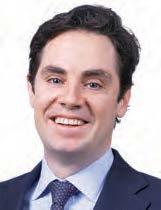
e pandemic and in ation make the need for more a ordable housing units more critical, advocates say. Demand for a ordable housing exceeded supply in Chicago by 159,000 units even before the pandemic, according to the institute.
So far little progress has been made since Lightfoot’s announce-
ment, and a ordable housing proponents and activists question whether a real commitment exists. To date, zero dollars have been spent on developing mixeduse projects that include a ordable housing. None of the 24 Low-Income Housing Tax Credit developments has broken ground. Only $450,000 has gone to owneroccupied repair grants, according to the Chicago Recovery Plan update report.
Marisa Novara, commissioner of Chicago’s Department of Housing, says 17 of the 24 developments are scheduled to close on nancing by the end of 2023. In total, the department expects 31 a ordable housing projects to have closed on nancing by the end of next year. Some of the developments are from a previous funding round.
Two of the upcoming LowIncome Housing Tax Credit developments, the Laramie State Bank redevelopment in Austin and rive Englewood, are part of the Invest South/West initiative designed to revitalize disinvested communities. Austin is 58.7% renter-occupied with nearly 30% of the population living below the poverty level, compared with 18% for the entire city of Chicago.
Englewood is 23.8% renter-occupied, and 40.8% of the population lives below the poverty level.
Crain’s reported in September that after three years, no Invest South/West developments had begun construction.
e Austin project is scheduled to close on nancing this month and can potentially begin construction this year, Novara says.
e Laramie State Bank site was proposed as a $37.5 million development with 76 a ordable housing units. rive Englewood, estimated to cost $28.4 million, will include two phases with a total of 103 apartment units with 10 qualifying as a ordable. e rive plan was approved in the summer, but representatives of DL3 Realty, the developer, have not indicated when ground will be broken.
In ation has driven up the costs of materials, and that means project budgets will have to be rethought, Novara says.
Last spring, the Chicago City Council approved the acquisition of several lots at the intersection of Peoria and 18th streets in Pilsen for $12 million with the intent to create a ordable housing.

In mid-December, three scenarios for developing the site were presented to the community. A 30-day public comment period will follow a formal proposal that will be drafted in January for the site. No developer is currently slated for the project.
Teresa Fraga, a longtime Pilsen resident and community activist, has been involved in the process with the vacant land since 2005 as part of the Pilsen Land Use
Committee.
Fraga, who has attended community meetings about the development, says the biggest issue is making sure the city keeps its promise of making the development 100% a ordable. She says that during some of the meetings, there has been backpedaling on the promise, with representatives of the Department of Planning & Development saying the development would be “mostly a ordable.”
“ e DOH is not saying what the percentages of (a ordability) are,” says Fraga, who says that if 100% a ordability isn’t viable, she wants to be given a reason why. She says that if it can’t be 100%, then part of her job is knowing how many years any a ordability requirements will stay in place.
Chicago’s housing costs cause much discontent
Chicagoans feel in ation’s effects with every purchase and every bill. And while costs are up across the board, rising rent is one of the biggest stressors. Housing typically consumes the largest portion of Americans’ monthly budgets, but this year it constitutes an even heavier burden.
According to a recent Harris Poll survey, 78% of city residents agree that Chicago lacks sucient a ordable housing. While government assistance programs exist to support low-income households, the level of nancial need outpaces available resources, leaving many families with nowhere to turn. ree in 10 city residents consider their housing situation unstable— an unacceptable level of such insecurity for the nation’s third-largest city.

Americans are often advised to keep housing expenses at or below 30% of their monthly income. However, few Chicago residents can secure a low enough price to stay within these guidelines: Almost half (47%) of city residents spend more than 30% of their annual household income on housing. Even
more concerning, 22% spend more than half of their annual household income on housing. is makes it di cult for families to a ord other basic necessities, including food, clothing and transportation.
Chicago’s minimum wage sits at $15.40 an hour. While that is higher than the rest of Illinois ($12 an hour), the city’s housing wage— the amount one needs to earn to be able to a ord basic housing— is $24.98. at gap signals that many of Chicago’s lower-income workers cannot nd reasonably a ordable housing. And while the need for rental assistance is high, only a quarter of households who qualify actually receive it. Others remain on waitlists for years in a fruitless e ort to secure nancial support.
Seven in 10 city residents (71%) agree that Chicago lacks su cient low-income housing. ere were 442,175 extremely lowincome renter households in Illinois last year, according to a 2021 study from the National Low Income Housing Coalition and Housing Action Illinois, but there are only
174,086 a ordable rental homes. e number of households living below the poverty line, in other words, is more than double the number of a ordable rental options.

Chicagoans are not optimistic that housing a ordability will improve in the near term: Almost half (45%) of city residents think it will be worse ve years from now. is year, average rents in the city of Chicago increased 9.4% from 2021. Residents’ pessimism will ring true if this foreshadows what’s to come.
Despite the rising rents, the grass is not always greener, or less expensive, elsewhere. More than half (60%) of city residents think that housing a ordability is worse in Chicago than it is in other U.S. cities. Despite this perception, however, Chicago is not in the top 10 most expensive U.S. cities for housing. According to Consumer A airs’ city rankings (based on median housing costs), Chicago ranks 13th, with a median monthly housing cost of $1,356. is is roughly half of the medi-
an housing cost in San Jose, Calif., ($2,463 per month), the most expensive city on the list.
Regardless of how the city ranks, Chicagoans are ready for their a ordable housing crisis to end. Eighty percent of city residents support developing additional a ordable housing, and 70% support establishing more low-income housing in the city. e question is, who will ensure that new a ordable housing is available to those who need it?
Chicago residents primarily look to city leadership (40%, making it the top response) to take the lead on issues related to housing a ordability. Mayor Lori Lightfoot seems to understand Chicagoans’ exasperation with steep rent, recently announcing a plan to bring more a ordable housing to LaSalle Street in the Loop, for example. As part of the project, private developers would be granted taxpayer dollars and tax incentives if 30% of the residential units are leased at a ordable rates.
With Chicago’s mayoral election just months away, Lightfoot is smart to respond to her constituents’ needs. As is often the case when our political system works, good policy—in this case, addressing the city’s a ordable housing problem—aligns with good politics.
14 DECEMBER 19, 2022 • CRAIN’S CHICAGO BUSINESS
William Johnson is CEO of e Harris Poll, a global public opinion polling, market research and strategy rm.
The billion-dollar investment promised a year ago leaves some residents questioning the commitment
AFFORDABLE HOUSING
Laramie State Bank on Chicago Avenue
WIKIMEDIA COMMONS
Committed to a stronger Chicago
Safe, a ordable housing serves as a cornerstone for stability in our communities. We are proud to partner with developers and housing organizations across Chicagoland to bring new and rehabilitated housing to our neighborhoods. Over the last six years, we have provided over $500 million in financing throughout Chicagoland, mostly focused on a ordable housing. Together with our partners, we have created or rehabilitated almost 3,200 units to address a critical need in our city, including the projects highlighted here.
Chicago Lighthouse Apartments
Why it matters
First tax credit financed housing for visually impaired
What we delivered $31 million tax credit equity $28 million construction loan
6001 W. Lawrence
Why it matters
New construction for families in high demand area
What we delivered $16 million tax credit equity $29 million construction and bridge loans
South Lawndale Apartments
Why it matters Preservation of Section 8 housing
What we delivered $13 million tax credit equity $20 million construction and bridge loans
Emma’s Landing
Why it matters New construction for families in high demand area
What we delivered $19 million tax credit equity $34 million construction and bridge loans
Carlton Apartments
Why it matters
Preservation of single room occupancy units
What we delivered $13 million tax credit equity $20 million construction and bridge loans
Walnut Place Apartments
Why it matters
Preservation of housing for seniors
What we delivered $9 million tax credit equity $14 million construction and bridge loans
Learn more at cibc.com/US The CIBC logo is a registered trademark of CIBC, used under license. ©2022 CIBC Bank USA. Products and services o ered by CIBC Bank USA. Loans are subject to credit approval.
COMMERCIAL BANKING | CAPITAL MARKETS | PRIVATE WEALTH
AFFORDABLE HOUSING
the demographic perceived to be most in need of a ordable housing, advocates say. Most downtown units are studios and one-bedrooms, appealing to singles, couples without children and empty nesters.
City dollars, it is argued, could be more e ciently applied to affordable housing in North Side neighborhoods, where longtime residents are being priced out, or to disinvested South and West Side communities. “For the cost of building an a ordable unit downtown, you could create two a ordable units in the neighborhoods, in Lincoln Park or Lakeview,” says Rafael Leon, executive director of the Chicago Metropolitan Housing Development Corp.
It remains to be seen how much interest the city’s invitation will draw from developers and whether the economics will work for conversion in general and, more speci cally, for a ordable units.
“ e feasibility depends on how much the city is willing to o er,” says developer Mike Reschke, whose venture purchased the largely vacant BMO Harris Bank ofce buildings along Monroe Street between LaSalle and Clark streets.
VACANCIES PLAGUE LASALLE STREET
LaSalle Street was in peril before the pandemic as developers lured major banks to sparkling new ofce buildings: BMO Harris to the recently completed BMO Tower next to Union Station and Bank of America to the Bank of America Tower at 110 N. Wacker Drive.

e pandemic exacerbated the situation as o ce sta s retreated to working from home. Analysts expect the new normal will shake out as a hybrid schedule with workers showing up three days a week.
A quarter of the o ce space along the LaSalle corridor is vacant, the city notes in its invitation for proposals, and 36% of retail space is unoccupied, the highest of any downtown submarket.
e city is o ering funding assistance for up to three proposals to convert o ce space, with at least 30% of the apartments onsite to be a ordable units.
e government de nes a ordable housing as a residence that doesn’t cost more than 30% of a family’s monthly income. An individual or family can qualify for an a ordable apartment if they earn less than the Chicago area’s median income: $104,200 for a family of four and $73,000 for a single. e city sets maximum rents for apartments subsidized by low-income housing tax credits and other government incentives.
e city wants the a ordable units along LaSalle Street to be accessible to a cohort earning an average 60% of area median income, referred to as AMI. A family of four earning 60% of AMI, or $62,520, would pay no more than $1,539 for a three-bedroom apartment in a high-rise, assuming the tenant pays all utilities. In contrast, the
6 HURDLES TO MAKING AFFORDABLE HOUSING WORK ON LASALLE STREET
4. WINDOWS
Open office plans feature lots of floor space away from windows. That might be fine for rows of cubicles, but converting the space to residences with highly desirable natural lighting would be difficult and expensive.
5. MULTIBEDROOM UNITS
Access to supermarkets and fresh food is limited. The area is largely served by convenience stores and small grocers.
3. PLAYGROUNDS AND GREEN SPACE
Maggie Daley Park offers plenty of green space and playgrounds, but it also would be a 15- to 20-minute hike for families looking to take their kids to the playground.
average rent for a three-bedroom apartment in the Loop is more than $4,000, according to brokerage Downtown Apartment Co., although there aren’t many larger apartments available. A single person earning 60% of the AMI, or $43,800, would pay $1,044 for a studio in a high-rise building.
e city drew inspiration from an Urban Land Institute report issued early this year that o ered a blueprint for reimagining LaSalle Street. at includes providing new housing at a range of prices
“that would allow households at di erent income levels to live in the Loop,” as well as schools, grocery stores, medical o ces, cafes and restaurants. With an eye to an even more striking transformation, the report suggests a pedestrian plaza with pop-up kiosks, stringing lights between lampposts and painting the street. Such a sweeping transformation could be a bridge too far for some. “We don’t need street festivals downtown. ose belong in the neighborhoods and the parks,”
Similarly, open office floors tend to get converted into studio or one-bedroom apartments. Creating multibedroom dwellings that appeal to families would be architecturally challenging and costly to add additional plumbing for multiple bathrooms.
6. SHOPS AND RESTAURANTS
Most current food and entertainment options are geared toward office workers.
Reschke says. “We need people to come back downtown and go to work every day, not just Tuesday through ursday.”

COMPENSATING FOR LOWER RENTS
Developers will have to rst determine whether they can make money converting an o ce tower to residential, then calculate whether the city incentives can make the a ordable component attractive. e rental market is favorable.
e Loop’s residential occupancy is in the 95% range, although
landlords are still o ering incentives, says Maurice Ortiz, director of operations at brokerage Apartment People. ere are 33,879 apartments in the Loop (including the West Loop), with 2,295 under construction, according to CBRE. With interest rates climbing, the market to buy and sell homes has petered out, so more people will have no choice but to rent, says Justin Puppi, senior associate at CBRE. e addition of 3,000 to 5,000 Google workers at the ompson Center in about four
16 DECEMBER 19, 2022 • CRAIN’S CHICAGO BUSINESS
Continued from Page 13
LASALLE
Can converting office buildings along LaSalle Street to residential spaces
opers and affordable housing experts have doubts. Families, one of the
hood. Here are six points that highlight the limitations in converting LaSalle Street to a
address Chicago’s affordable housing crisis? Mayor Lori Lightfoot’s administration thinks so, but some devel-
groups most in need of affordable housing, might not find Chicago’s financial district an appealing neighbor-
residential area. By
Judith Crown and Jason McGregor
SCHOOLS
1.
GROCERY STORES
There are no public elementary schools in the Loop. Students who would live on this stretch of LaSalle Street would attend South Loop Elementary, roughly 1¼ miles away. By contrast, Austin has over a dozen CPS elementary schools, and Lakeview has nearly 10. 2.
WACKER JACKSON ROOSEVELT MICHIGAN STATE LASALLE LAKE SHORE DRIVE South Loop Elementary School LaSalle Street corridor 1.2 miles To South Loop Elementary School 0.6 miles To Maggie Daley Park
Maggie Daley Park
years will add to the demand for housing, food and other services.
Developers gain an advantage if they can purchase a distressed building at a discount. A conversion works because the shell of the building can be worth $80 to $100 a square foot. “ e advantage of renovating is that you’re getting the shell for less than replacement cost,” says David Brint, principal and co-founder of Evanston-based Brinshore Development, which specializes in a ordable projects.
“ at is, in and of itself, a subsidy.”
Probably the single biggest obstacle is the size of the oor plate.
ose large interior expanses that house rows of worker cubicles don’t have windows and limit the
amount of rentable space. Developers try to carve out atriums, but those can only work for several oors, not the entire height of the building. Most of the apartments in the Loop are studios and one-bedrooms.
“Can you convert o ces to two- or three-bedroom units with multiple bathrooms to attract families?” Ortiz says. “I can’t even imagine the cost.”
Developers will weigh whether TIF money and other incentives compensate for lower a ordable unit rents. ey can also bene t from generous property tax breaks adopted by Spring eld lawmakers last year.
Market-rate developers may
team with a ordable specialists who know the full range of tools available, including low-income housing tax credits, historic tax credits, and other incentives and loans. A typical project could carry eight to 10 nancing sources in the capital stack. e subsidy money is allocated only to the a ordable portion of the project, “which is an exercise in creativity,” Brint says.
For his part, Reschke is considering a $180 million project to turn the top 12 oors of two towers at the former BMO headquarters into more than 300 apartments. (He’s selling a third tower to the state of Illinois for its new o ces.) He plans to submit a proposal to the city and says he doesn’t require a partner specialist in a ordable housing. “If the subsidy doesn’t make up the delta, we would look to go all market rate,” he says.
Another developer expected to be in the mix is Related Midwest, which handles market-rate and a ordable projects. A spokesperson declined to discuss plans, saying only that it’s “supportive of the city’s e orts to build more affordable housing in the Loop and other neighborhoods. Ensuring equitable access to housing across income spectrums is both critical to the economic vitality of communities and key to the continued success and growth of Chicago.”
en there’s the question of what level of rents can be charged for the market-rate units. Average rents in the Loop range from 33% to 50% above city averages, making the Loop inaccessible to many residents. Yet they’re lower than in neighboring River North, River West and Streeterville, which could discourage investment. You can get (top) rents by Grant Park,” Brint says. “When you get into the core of downtown, it’s another question.”
But creative developers could nd a hook. Why not o er a membership to the nearby Lyric Opera of Chicago, suggests Michael Mazzei, senior vice president at Berkshire Hathaway HomeServices. “You could make the neighborhood about the arts,” he says.

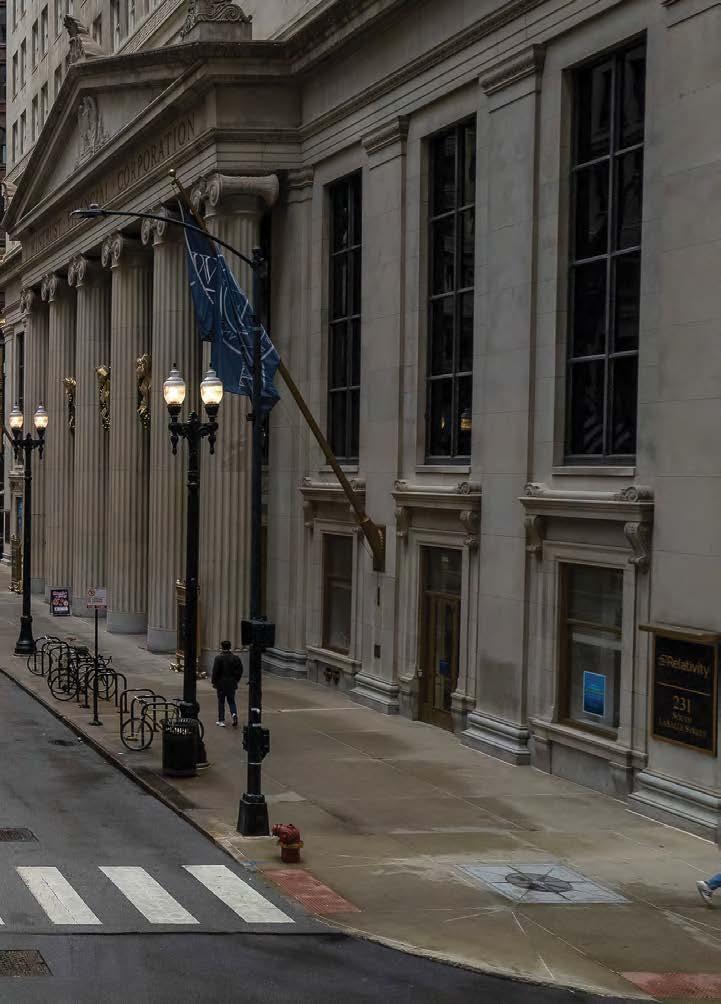
It wouldn’t be the rst time a com-
mercial zone became a residential neighborhood. Fulton Market, once a meatpacking district, famously transformed into a trendy hub for Google and other tech companies, popular restaurants, and apartment buildings stocked with perks for singles, couples and families.
A SCARCITY OF AMENITIES
Will apartment renters, whether in the market-rate or a ordable brackets, want to live on LaSalle Street?
ey will if it’s an easy walk to the o ce, says Ben Creamer, managing broker at Downtown Apartment. “One of the biggest factors our clients consider when moving is proximity to work,” he says. “Even if they aren’t in the o ce every day, it’s an important part of their search.”
Despite the stately architecture on the street, the buildings are so tall that they don’t allow in a lot of sunlight, which may be a turno to apartment seekers. And there are few amenities. e shops and restaurants are geared toward ofce workers, and activity quiets down on evenings and weekends.
e lack of grocery stores is one of the biggest obstacles. ere are a few supermarkets on Roosevelt Road and South Halsted Street, but it could be di cult to haul a load of groceries home without a car. e city says funding assistance is available for developers providing a grocery store and locally owned cultural and dining businesses. Is it possible to carve out space for a 50,000-square-foot supermarket, or will residents have to settle for convenience stores?
Life in the Loop would be a stretch for families. LaSalle Street lacks views and access to parks and the lakefront enjoyed in Lakeshore East and along Michigan Avenue, where more shops and restaurants are located. Grant Park is only ve blocks to the east, but getting to the playground in Maggie Daley Park near the lake and Randolph Street is a long walk.
Probably the biggest obstacle for families is an absence of schools.
Elementary school students living on LaSalle Street would have to
walk more than a mile to the nearest public school and cross Roosevelt Road. at’s why, in the end, a ordable units in the Loop will be best suited for residents who don’t have children and work at downtown restaurants, hotels, government ofces and health care facilities.
Meeting the enormous demand for a ordable housing could be accomplished more e ciently by focusing on less-expensive neighborhoods, advocates say. An estimated 160,000 units of a ordable housing are needed in Cook County, according to the DePaul University Institute for Housing Studies. at’s largely in North Side neighborhoods where longtime residents are being priced out.
“ e city cannot bridge that,” says Leon of the nonpro t Chicago Metropolitan Housing Development Corp. “We need more investment in the neighborhoods working with the private sector.”
e government and legal infrastructure that supports government tax credit programs adds hundreds of thousands of dollars to the cost of building an a ordable apartment, Leon says.
For example, the process of allocating and awarding subsidies such as federal low-income housing tax credits is complex and lengthy, supported by a network of state and city administrators, lawyers and accountants.
Rather than subsidize a ordable units in a downtown o ce building at a cost of $400,000, rehabbing units in existing neighborhood buildings costs between $150,000 to $250,000 and can be accomplished without subsidies, he says.
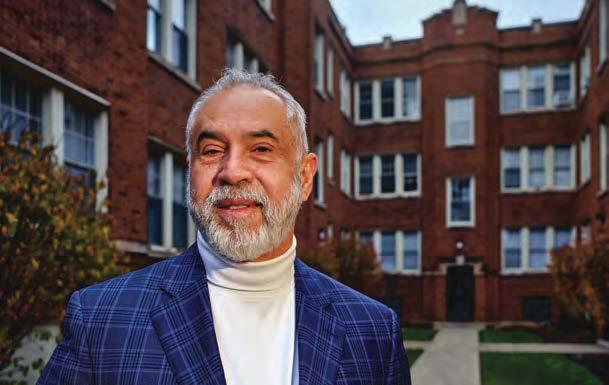
Adding a ordable units in the Loop would bring valuable diversity to the neighborhood and make downtown more accessible. Will it further the revitalization of LaSalle Street? Will it make sense for developers and help bridge the shortage of a ordable apartments?
“You need the right product with the right amenities for everyone,” says Puppi at CBRE. “Make it a place where people want to work, live and play.”
CRAIN’S CHICAGO BUSINESS • DECE M BER 19, 2022 17
JOHN R. BOEHM
Rafael Leon, executive director of the Chicago Metropolitan Housing Development Corp.
Developer Mike Reschke
LaSalle Street
GEOFFREY BLACK
GEOFFREY BLACK
Local experiments show promise, but more can be done
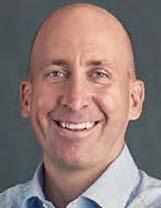
As Palenque LSNA, a community-based organization in northwest Chicago, we are at the front lines of a housing justice movement. We are concerned with the ways our housing market rewards cruelty and greed while penalizing solidarity and the common good. Cycles of boom and bust in the housing market in Chicago are immensely profitable for large investors and corporations while detrimental to everyone else, and this should concern us all.
Consider property taxes, which have shot up 8% on average throughout the region. In Latinx neighborhoods, the increase is in the upper 20s. Large commercial developers successfully shifted the tax burden to residential homeowners, hitting communities of color hardest. e potential harms (and on the ip side, bene ts to speculators) pose an existential threat to diversity on the Northwest Side. Meanwhile, our majority Black South and West sides continue to suffer from neglect and disinvestment, which also cause displacement and violence. How can the public sector mitigate historic patterns of exclusion and begin to reward actors who are motivated by stability in housing development, instead of solely pro t? Local experiments show promise that cycles of boom and bust in housing

are far from inevitable, but we need to do more.
At Palenque LSNA, we are living these experiments. We’ve:
Established a community land trust to acquire land and homes to preserve them as a ordable homeownership opportunities in perpetuity.
Worked with alders on equitable communitydriven zoning that has led to community bene ts agreements as a more common practice, especially in the 35th Ward.
Helped lead e orts to increase the a ordable requirement from 10% to 20% in gentrifying neighborhoods, with incentives for family-size units and true a ordability accessible to those who live below 60% of the area median income.
Won hundreds of a ordable homes which are built or in the pipeline, such as the Lucy G. apartments, Encuentro Square or the upcoming development at 2525 N. Kedzie Ave.

Banned demolitions along the Bloomingdale Trail for a year and won a demolition impact surcharge to help fund land trusts when a ordable housing is torn down.
Made it di cult to deconvert multifamily housing into single-family homes in gentrifying neighborhoods.
Made building a ordable homes near transit easier and cheaper to developers by
championing the Connected Communities Ordinance.
ese victories show it is possible to change the rules of development. ese reforms o er hope, but we’ve only scratched the surface. Our experiments are meant to legislate and combat violent uctuations in the housing market. Housing is a human right, a need deserving of special protections and regulations against speculation
Housing crisis can’t be fought in a vacuum
“Why are people camping in the park?” This question from one of my four children shocked me out of a traffic-induced haze. The growth of tent cities in Touhy Park, under viaducts and along expressways provides a jarring reminder of the housing crisis in our midst.
But there are more subtle reminders. A well-established nonpro t housing developer recently completed construction of 51 a ordable apartments in Chicago. Over 1,000 quali ed people applied.
In my hometown of Dixon, a recent study found only three available rental apartments in all of Lee County. Under normal market conditions, there would be over 220 vacant rental apartments at any one time. Local leaders fear that this shortage of rental housing will prevent job growth and

business expansion, especially in manufacturing.
ousands of vacant lots, many of them city-owned, plague the South and West sides of Chicago, representing the rubble of racial and economic segregation and the aftermath of redlining, contract buying and the loss of manufacturing jobs.
is lack of homes, both owned and rented, threatens the viability of our state. It reduces our tax base, limits population growth, discourages business expansion, exacerbates mental health crises, increases health care costs and recidivism in the criminal justice system, and prevents working people from building wealth and climbing to the middle class.
What’s happening re ects a larger national trend. Studies show that our nation has


been underproducing homes for nearly two decades. Our nation produced fewer homes from 2008 to 2018 than in any decade since the 1960s. We now face a de cit of nearly 4 million new homes. As a country, we used to build for working people. Today, we build largely for the a uent—and then try to shoehorn in a few homes for working people via local mandates or incentives. Only 8% of new construction homes today are starter homes, compared with nearly 70% in the 1940s.
What’s the answer to this lack of supply? Build more homes, of all kinds, in urban, suburban and rural communities. Build more starter homes and a ordable apartments. And make existing housing more a ordable with a recommitment to targeted rental assistance. Supply-chain issues, increased material costs, rising interest rates and a broken immigration system increase the degree of di culty, but there is plenty that we can do together.
and unbridled greed. Housing is not something to be played with like shares in the stock market.
Part of Palenque LSNA’s mission is to make it more di cult for investors to only invest in gentrifying neighborhoods. We understand that the paradigm we exist in is one of speculation and pro t, so we do need to create incentives to encourage developers to invest in the whole of our city.
18 DECEMBER 19, 2022 • CRAIN’S CHICAGO BUSINESS
CHANGING
e federal government can act in several ways. One, expand tools that have proven their worth. Increase the Low-Income Hous-
THE RULES
Juliet De Jesus Alejandre is executive director of Palenque LSNA, a multiissue community organization serving residents across Logan Square, Hermosa and Avondale in Chicago. Christian Diaz is director of housing at Palenque LSNA and co-chair of the Illinois Senate 20th District Housing Roundtable.
Nick Brunick is a partner at Applegate & orneomsen, a Chicago-based law rm that specializes in a ordable housing and economic development.
FACTS OF THE MATTER
Local experiments show there are innovative ways to create housing stability in Chicago, but we need more allies in our struggle for housing justice, so this is an invitation to stand in solidarity with us. Violence, crime and population loss are the byproducts of harmful investment and speculative disinvestment and they hurt us all, not just targeted and vulnerable populations.
Preserving a ordable housing is fundamental for Woodlawn

Discussions about the Obama Presidential Center’s potential impact on housing a ordability in Woodlawn often focus on residents’ fears of displacement and an uncertain future, but it might be more useful to look at the past decade for models of what can be done moving forward.
For decades Woodlawn was an undervalued and underinvested community—too many empty lots, low market rents, the lack of a full-service grocery store, few jobs and fewer amenities.
Over the past decade, however, reinvestment sparked by a $30 million Obama-era federal grant has begun a turnaround in the community—increasing property values, new homeownership opportunities and new jobs, and attracting that long-sought grocery store and other smaller new businesses, all the while protecting and expanding a ordable housing opportunities.
e Preservation of A ordable Housing’s experience in Woodlawn o ers some key lessons. As a nonpro t mixed-income housing developer, we helped facilitate homeownership opportunities and new rental development while also implementing the most cost-e ective strategy of all—the preservation of existing a ordable housing.
Since 2009, POAH has acquired more than 1,000 apartments here, the lion’s share in East Woodlawn, where gentri cation pressures are greatest.
It’s not easy work. In every case, successful preservation has required partnerships—with public funders, of course, but also with community organizations, residents and even with other developers. And, of course, money.
Most recently we teamed with Jonathan Rose Cos. to buy the 318-unit Jackson Park
gram with a proud history extending all the way back to Lincoln’s land grants for home settlers). Pass the Neighborhood Homes Investment Act to spur private construction of starter homes on vacant lots and explore broad-based tax reductions to encourage development of multifamily housing.
Two, reinvest in rental assistance. It has been almost four decades since our nation abandoned investing in new streams of rental assistance and resorted to merely funding rental assistance obligations already in the marketplace. During that time, the economy has grown radically more unequal (in terms of both wealth and income) and a larger share of our workforce labors for low wages.
e results have not been surprising. More people now need to spend more of their income on rent; there is not enough rental housing a ordable for people who work in the service sector for modest wages; and homelessness has dramatically increased.
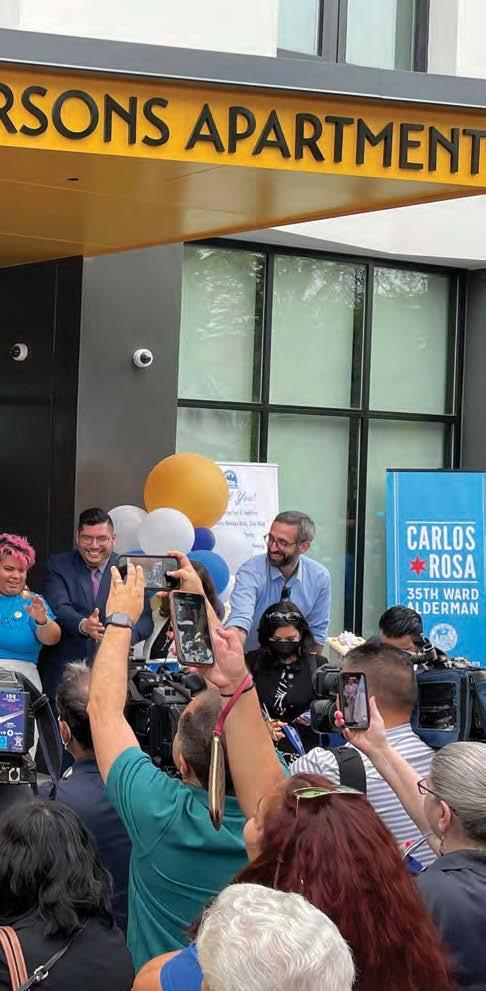
Terrace immediately across Stony Island Avenue from the Obama Presidential Center. e property’s asking price exceeded what POAH could a ord alone. New York-based Rose, meanwhile, wanted to underscore its commitment to preservation and resident support and invited POAH to join its bid. Today the property is in the hands of two preservation-focused partners for the foreseeable future.
A few blocks south, 20-story Island Terrace required another approach. ere, lining up early support from city, state and federal funders helped chart a path to a purchase and recapitalization plan that will begin in early 2023 and result in more a ordable apartments than exist today overlooking Jackson Park. ere are more modest examples as well. In 2019, more than a year before his death, the Rev. Leon Finney Jr. sold the Fr. Martin Farrell House on East 65th Street to POAH, securing long-term a ordability for 59 senior apartments.
Just north of there, longtime community and a ordable housing activist Mattie Butler and Woodlawn East Community & Neighbors (WECAN) looked to POAH to revitalize 106 apartments serving people at risk of homelessness. Today, following an award-winning rehabilitation, the renamed Butler Apartments secure her legacy with service-enriched supportive housing on Kimbark and Dorchester avenues.
Every building preserved used multiple tools, including short-term acquisition funding, followed by longer-term support from City Hall, the state, the U.S. Department of Housing & Urban Development and others; creative partners committed to the properties’ long-term health; open communication with residents worried
about change; and public messaging reinforcing the vital role preservation plays in a community’s vitality and ecosystem.
What’s known as NOAH, or naturally occurring a ordable housing, is often harder to protect. Owners of buildings that operate without subsidy but have generated only modest revenues for years can hardly be blamed for raising rents as a neighborhood improves, or for selling to investors. But as those modest rents disappear, lower-income residents often are priced out.
Protecting these NOAH properties requires a di erent tool set—low-interest loans, property tax incentives, etc., and attention from the city, county and lenders such as Chicago’s Community Investment Corp., which focuses on this inventory.
e city adopted the Woodlawn Preservation Ordinance to help protect this essential community asset, and that work is ongoing.
Preservation is obviously central to a healthy Woodlawn but remains just one critically important piece of the puzzle. With acres of vacant land to build on, new construction should transform Woodlawn’s streetscape in coming years. Here, too, balance is possible. As much of that land—along 63rd Street and on residential blocks—is owned by the city and Cook County, any surge in higher-end housing can be both welcomed and balanced with moderately priced options for middleincome households.
And as the housing stock increases, even more commercial activity will follow. Here, too, experience shows that, with the right players and incentives, large-scale operators such as Jewel-Osco on 61st Street can coexist with smaller entrepreneurs such as Daley’s Restaurant two blocks away.
Balance. Committed partners. Creativity. Money. New and longtime residents. For a thriving Woodlawn today and tomorrow, they all matter.
building boom in our nation’s history has been birthed from the muscles, ingenuity, engineering and craftmanship of immigrants. Our urban, suburban and rural communities would all bene t from immigrant labor, culture, investment and new business formation. And our democracy would bene t from more people yearning for liberty and freedom.
State government can participate in the solution by continuing to invest in, supplement and leverage proven federal housing strategies. e Illinois General Assembly can build upon recent housing legislation by dedicating funds for rental assistance and for homebuyer subsidies, passing the Build Illinois Homes Tax Credit to draw down more federal Low-Income Housing Tax Credits, and continuing to dedicate and release state capital and American Rescue Plan Act dollars for the production of both a ordable apartments and homes.
Speed up permitting processes and approval times, waive permitting and impact fees for a ordable homes, and remediate and transfer vacant lots to developers who are building homes at scale. Remove obstacles. Move available funding sources. Focus on the outcome. Produce more homes. We need our elected o cials, regardless of ideology or political a liation, to focus not just on running for o ce but on running the o ce.
Corporate, civic and private leaders can contribute to this cause by advocating with elected o cials and by raising private funds for the production of a ordable homes. Public dollars often come with excessive strings and bureaucratic process. When Chicago wanted to step out on the world stage and to pave the way for its future growth, an array of leaders raised money for and organized the World’s Fair of 1893. A similar e ort is needed now for housing.
ing Tax Credit and the capital programs that are used with it. Expand homebuyer grants to help working families buy homes (a pro-
e economics of producing and operating high-quality a ordable apartments do not work without rental assistance.
ree, return to our nation’s roots and welcome more immigrants to our shores. Every
Local government can follow the advice given by former Cubs manager Joe Maddon when he recently returned to town: “Do simple better.” Make government work for housing production. Zone more land for starter homes and multifamily housing.
Our democracy remains, as Lincoln so aptly phrased, the last best hope of Earth. But hope will die without action. We can meet the challenge of the housing crisis. Not with any one action. But if we act together, there is no limit to what we can do.

CRAIN’S CHICAGO BUSINESS • DECE M BER 19, 2022 19
TURNAROUND
Bill Eager is senior vice president, Midwest region, for Preservation of Affordable Housing.
Room available in ‘missing middle’ housing
It is a human right for people to have decent, safe and affordable housing. Unfortunately, that’s often not the case in Chicago. For more than 50 years, The Habitat Co. has worked in close partnership with the government, housing agencies and fellow developers to deliver more affordable residential options. But even with unprecedented commitment from the city and state for affordable housing resources, the need remains greater than what can be produced.
ere’s a shortfall of 120,000 a ordable housing units in Chicago, according to a 2021 DePaul Institute for Housing Studies report—a number that is likely much higher this year when factoring in high in ation and rising rental costs. To shrink that gap, we need to make it easier and more economically feasible to develop and access quality, a ordable housing, and work together to maximize available funds and programs.
e federal government sets an income a ordability standard for housing at 30%,
so any household paying more than 30% of its post-tax income on rent is considered cost burdened. e benchmark for housing assistance in Chicago is at or below 60% of the average area median income, or AMI, which means to qualify, an individual would need to make less than $43,800 a year or $50,040 or less for a two-income household.
Most successful global cities have a diverse population and talent pool—from service industry employees to high-tech gurus—and su cient housing options to meet their needs. However, Chicago’s housing chasm is creating a more expansive “missing middle,” those at 60% to 120% of the AMI. Not only are there not many incentives or public dollars available for this moderate-income group, but it’s also primarily composed of younger families and seniors—those who often struggle the most on xed incomes.
One solution to increase missing middle housing is through equitable transitoriented developments, or ETODs, which
became easier when the city passed the Connected Communities Ordinance earlier this year. rough the ordinance, transit-oriented development incentives were extended more broadly and equitably across the city, allowing buildings within a four-block radius from rail stations and two blocks from high-frequency and strategic bus corridors to qualify as TODs.
We know rsthand the desire and community support for new, quality a ordable housing, and research has also shown the immense bene ts of ETODS, including health improvements, easier access to jobs and thousands of dollars in household transportation cost savings per year. When 43 Green, our mixed-use/mixed-income project in Bronzeville with development partner P3 Markets, delivers its rst building in early 2023, it will be the rst ETOD on the city’s South Side. Over 300 applicants have already put in letters of interest for one of the 100 a ordable or market-rate units there prior to preleasing.
Funded in part by the city’s Low-Income Housing Tax Credit allocation, 43 Green is a great illustration of what can happen when private developers, local and state government, and the community as a whole work together. With similar mixed-income projects on the horizon, like Park Station Lofts at 63rd Street and Maryland Avenue being built under the Woodlawn Housing Preservation Ordinance by e Michaels Orga-

nization and DL3 Realty, there is optimism that city programs are gaining momentum.


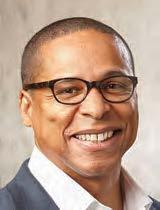
Coupled with Mayor Lori Lightfoot’s groundbreaking Invest South/West initiative, the table is set for developers to explore missing middle opportunities in underdeveloped neighborhoods near transit lines on the South and West sides in 2023 and beyond.
Another step forward is Illinois House Bill 2621, which was signed into law in 2021 and supports nancing programs and tax incentives for the creation and preservation of a ordable housing. A provision of the legislation encourages owners of multifamily buildings to invest in their properties and keep rents a ordable by providing reductions in post-improvement assessed value. However, with many existing a ordable buildings in the city seeing signi cantly increased tax bills, additional steps must be taken to bring costs in line.
To have a long-term impact, it’s essential for the city to incorporate more of these incentives and expand others, including land donation, abatement of the sales tax for construction materials, a streamlined permitting and entitlement process and reduction of fees associated with a ordable housing, to name a few. Combined with creative government programs and resources, social impact investing from the private sector and community involvement, together we can nd our missing middle.
20 DECEMBER 19, 2022 • CRAIN’S CHICAGO BUSINESS
Charlton Hamer is senior vice president of Habitat A ordable Group and oversees Habitat’s a ordable portfolio consisting of 9,000-plus units in Chicago and St. Louis. Je Head is vice president of development for Habitat A ordable Group and manages the nancing and development for Habitat’s a ordable housing portfolio.
POINT OF CONVERGENCE AFFORDABLE HOUSING
Amid city’s opulence and decay, a ordable options beckon
The past three years have forever altered how we live, work and interact. As we recover from the pandemic, we should remember how low-income individuals and families are often left in the lurch. More than that, it is our responsibility to attempt to fix the systemic issues that have made recovery difficult for those neighborhoods hardest hit. These issues, while vast and complex, are most appropriately answered with the proper institution of affordable housing.
A ordable housing as a concept carries both unfair stigma and expectation. Many would consider it to be one among many tools for the bene t of low-income communities, but we believe that in the city of Chicago it goes further than that. In Chicago, a unique tapestry of neighborhoods that display both extravagant opulence and corrosive decay, a ordable housing is a necessary step in the catalytic transformation of neglected neighborhoods.
In order for the city to ourish, its re-

sources must be thoughtfully distributed. For areas such as Fulton Market, Lincoln Park, Gold Coast and Old Town, the next high-end, mixeduse development that gets built in those neighborhoods will not be the last. ese developments should continue. However, for the city to truly grow and be accessible for all, the resources must be prioritized for the South and West sides.
No developer, even with the best intentions, plans to lose money for the bene t of these neighborhoods. at is why the city must take the lead by being the rst investor. In this way, Mayor Lori Lightfoot’s Invest South/West initiative, or ISW, is a unique ashpoint. Previous administrations have authored and implemented signi cant public works campaigns and economic development programs that were hugely successful and impactful to the city. However, the di erence with ISW is that it is the rst articulated program that focuses the city’s resources and atten-
tion to the areas of the city and people that need it most.
erein lies the opportunity for developers. Never has an administration signaled their intentions clearer than what the city has done with ISW. Developers need to take the proverbial ball and run with it. If we take this opportunity to develop those projects previously only considered “for the North Side,” we can create new wealth and transform the landscape to be safer and healthier both for those who already live in these neighborhoods, and the new visitors inevitably attracted to see aspects of the city that were previously unable to shine.
All neighborhoods have value as integral parts of Chicago’s past and its future.
e beautiful history of the Back of the Yards illustrates the need for the investment in a ordable housing. e aesthetics were never world class, but the fabric of the stories of triumph and perseverance laid the groundwork for the American Dream for tens of thousands of families—one of the authors included. is community like no other served as an entry point for families around the world to start a new and better life. Around the turn of the century, housing in the Back of the Yards was built to accommodate as many workers from the Union
Stockyards as possible. Many of those twoand three- at wooden structures still exist today, and they do not provide modern-day amenities that every Chicagoan deserves. e impact in our community of new housing would be profound.
Low-income communities like Back of the Yards are unique but share common challenges. So, we make the following suggestion: For-pro t developers should nd neighborhoods that they may not have typically considered for investment and partner with a community development organization within. For-pro t developers have access to resources that community groups typically do not have. Community groups have invaluable intel on their communities that for-pro t developers do not have. rough communication and combined e ort, impactful wants and needs of the community can be understood, and the signi cant resources that the city is contributing can be leveraged to truly make a di erence.
HOUSING IS
NECESSARY STEP IN THE CATALYTIC TRANSFORMATION OF NEGLECTED NEIGHBORHOODS.
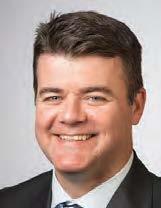
CRAIN’S CHICAGO BUSINESS • DECE M BER 19, 2022 21 ON THE OVER 6 IN 10 READERS BELIEVE CRAIN’S GIVES THEM A COMPETITIVE EDGE Stay Ahead of What’s Next in Industry News RECOGNIZE TOP ACHIEVERS IN CHICAGO’S PREMIER PUBLICATION MERGERS ACQUISITIONS NAME CHANGES NEW BUSINESS LINES MAKE AN ANNOUCEMENT! Debora Stein | dstein@crain.com
Matt Mosher is principal and co-founder of Park Row Development. Craig Chico is the CEO of the Back of the Yards Neighborhood Council.
PRIORITIES
AFFORDABLE
A
“Our focus on this event is to drive interest and awareness (to) reach new fans,” says Julie Giese, president of NASCAR’s Chicago Street Course.
It’s no secret as to why: NASCAR has to change something to rebuild its audience. Its average national TV viewership has shrunk to just over 3 million people per race, barely half of its size 10 years ago, though that drop may be partly a product of fewer people subscribing to pay-TV or streaming services. Stock car racing has been gradually reverting to its roots as a regional Southern sport, a far cry from its glory days two decades ago, when its popularity exploded nationally. Ratings for the Daytona 500 topped the World Series for four years in the mid-2000s.
NASCAR’s turnaround strategy targets fans in big cities with unorthodox events: A race earlier this year on a miniature track inside the Los Angeles Memorial Coliseum helped generate a 24% boost in season-long NASCAR viewership in that market, according to Nielsen. Giese notes that 70% of attendees had never been to a NASCAR event before. Another promising sign: Despite many U.S. households dropping pay-TV subscriptions in recent years, TV viewership for NASCAR’s regular season rose 4% this year, reversing a decade of steady ratings losses.
Now it’s wagering Chicago can turbocharge its push to reach new
fans. If the plan works, it could establish the city as an unlikely NASCAR hub for years to come and set o a new era of American stock car racing.
“ e city of Chicago is really an incubator of sorts to launch what the next version of the sport might look like,” says Toure Claiborne, an executive at Chicago-based media and marketing rm Intersport who negotiates sponsorship deals with NASCAR for corporate clients.
NASCAR has tried using Chicago as a springboard before. e circuit moved its annual race at Chicagoland Speedway in Joliet from midsummer to the September opening event of what amounts to its playo s from 2011 to 2019, hoping to capture more attention in the nation’s third-largest market.
But luring fans to events 40 miles from downtown proved di cult. A mix of factors, including top drivers retiring, a lack of entertainment amenities near Chicagoland Speedway, bad weather and waning interest in the sport nationwide kept NASCAR from getting its intended payo from Chicago. e circuit ultimately pulled its race out of the area entirely in 2020.
Roughly 1.2 million people in the Chicago area—about 13% of the metro population—have at least some interest in NASCAR today, Nielsen Scarborough data shows. at’s down from 18% a decade ago and 26% ve years before that. In Charlotte, N.C., a traditional NASCAR market, the current share is about 28%.
NASCAR hopes for better luck in Chicago with a higher-pro le event featuring a 2.2-mile course touching Lake Shore Drive and Michigan Avenue, with the city skyline as a striking TV backdrop. Helping its cause is an enthusiastic partner in Mayor Lori Lightfoot, who’s eager to showcase Chicago on national TV at a time when its crime-sullied downtown desperately needs positive media attention.
“With NASCAR’s global appeal and media coverage, this event is an excellent way to showcase so many of the wonderful things about Chicago that make it a world-class city,” a Lightfoot spokeswoman says in a statement. e statement does not address pushback against the event from downtown aldermen who complained they weren’t consulted about the race before a deal was struck and criticized the terms as too generous to NASCAR. But the spokeswoman points to Lightfoot’s public comments from early August on those issues noting that all aldermen “were briefed ahead of time” and that the better NASCAR does with its event, the higher the nancial return will be for public co ers.
NEW EMPHASIS
e urban setting re ects NASCAR’s new emphasis on creating spectacles that will draw larger TV and streaming audiences, rather than solely focusing on lling massive grandstands at rural tracks. Broadcast rights fees, after all, were cited as the reason revenue rose by
1% in 2018 to $675 million for International Speedway Corp.—the publicly traded track owner that NASCAR acquired the following year—while revenue from ticket sales in 2018 fell by 10%.
e high costs of building out the street race downtown will likely turn the event into a loss leader for NASCAR, but one that will expose it to new viewers at a crucial time: e circuit is about to enter negotiations for a new media rights agreement as its current 10-year, $8.2 billion deal with Fox Sports and NBC approaches a 2024 expiration. Despite a drop in TV ratings since it negotiated the last TV deal, NASCAR reportedly seeks nearly 15% more.
“ at’s the power play” of the Chicago race, says John Rowady, president of Chicago-based sports marketing agency Revolution. Given the eye-popping sums that leagues like the NFL, NBA and Big Ten Conference have commanded for media rights, made-for-TV events like NASCAR’s L.A. and Chicago races “start to secure the value piece that they need in an upcoming TV deal,” Rowady says.
Giese, a veteran NASCAR marketing executive tapped to run the Chicago event after ve years leading Arizona’s Phoenix Raceway, notes that Chicago is one of NASCAR’s largest markets by total number of fans and stresses that the street race’s success will be measured by more than profitability.
“ e nancial side of this and
the dollars are not the driver at the event,” she says. “It’s that we’re reaching new audiences and bringing our sport to more people that haven’t been exposed to it before.”
So how does NASCAR plan to do better in Chicago than Joliet? e most obvious advantage is that the Chicago race will be easier for local fans to get to. But Giese admits that lakefront racing itself may not be the primary draw for Chicagoans next July. So NASCAR is marketing the twoday event as an entertainment festival with a pair of what she dubs “A-list concerts” after races on both days and food o erings from Chicago restaurants. NASCAR priced two-day general admission tickets starting at $269 and hired Four Leaf Productions to help stage it, a company led by longtime Lollapalooza event producer Charlie Jones.
Giese, who grew up on a Colby, Wis., dairy farm and aspired to become a geneticist before taking a sharp turn into motorsports, also sees science as a tool to attract new fans. NASCAR aims to partner with Chicago Public Schools and the Chicago Park District to highlight the STEM (science, technology, engineering and mathematics) side of stock car racing to kids in communities where NASCAR may not resonate, though it has yet tonalize any detailed plans.
“It’s di erent from Joliet,” she says. “We’re investing in and becoming members of the community in Chicago.”
Duffy and Tilly offer sharply differing perspectives on cryptocurrency’s future
it paid for ErisX, but the write-o clearly represented a substantial chunk of the value. Nonetheless, Cboe believes ErisX—now redubbed Cboe Digital—will generate substantial future growth.
What is the opportunity for Chicago’s long-standing commodities exchanges in what has been dubbed the “crypto winter”? “It really comes down to di erent views on the long-term potential of crypto itself,” says Michael Miller, an analyst with Morningstar in Chicago.
Crain’s spoke with Du y and Cboe CEO Ed Tilly about crypto and their companies’ interest in lling the breach left by FTX. Below are excerpts of those interviews, edited for clarity.
On whether a “use case” for cryptocurrency is a factor in deciding how much to get involved:
Du y: ere needs to be a use case for all products, and there is for everything CME lists. ere’s a use case for food and energy, interest rates—and for crypto there needs to be a time where the use case starts to prove out. We’re very cautious as it relates to this asset class because I do believe there needs to be a use case; otherwise, it’s just a pure speculative contract, and that’s not what we want to have. If it’s a store of value, then it should
have some kind of use case. Right now the way I look at bitcoin, there is no use case for it at all.
Tilly: My opinion on any of the thousands of stocks we list, the ETNs we list—my role as an exchange operator is to make sure that the trusted market, the one that you want to represent an opinion, that you’re able to do so fairly, equally and with equal access to everyone else that wants to express an opinion. at’s my role.
I don’t need to have a value idea on bitcoin, whether $60,000 was too much or $16,000 is too little.
On the need for U.S. regulation of crypto trading:
Du y: Do we need to have stablecoins and cryptocurrencies in order to eliminate that friction on the blockchain from a payment methodology? If we do, does the government need to make sure they’re involved? I believe they do. I think the Federal Reserve needs to be involved in that, as does the U.S. Treasury. If they want to call it United States bitcoin or the U.S. stablecoin or whatever, as long as there is a stamp of approval and oversight by both Fed and Treasury, then I think the use case can be proved out and we’ll continue to list that for trade.
Tilly: Regulate my platform—we are all in and all for it. e rigor at which our regulators look at our
operations, this will be nothing new for Cboe. We expect it and we embrace it. Our role is to make it easy as an exchange operator for our regulators to learn as we go. Are we going to get this right the moment we jump into regulation and oversight of crypto more broadly? Probably not. Like the U.S. market structure, it needs to evolve. And our role is to provide as much information to the CFTC and SEC as we possibly can.
On whether Washington will take action to make crypto trading safer:
Du y: One of the things I’ve learned not to do is predict. If asked to participate (in Washington), I’m always happy to. I’ll give you an opinion. I do believe that the caution ags on the racetrack are out right now, and if people believe that they’re going to continue on a pace that they’ve been on the last couple of years, I think they’re kidding themselves. ere are a lot of questions that need to be asked and answered as it relates to the latest debacle. If anyone’s looking for a clear, quick, concise answer to what’s going to happen, I think they’re crazy.
Tilly: We’ve found the committees that are charged with safety and protection for investors pretty bipartisan, which is really refreshing from an operator’s perspective. I’m actually optimistic
that something moves forward. On crypto’s future as an asset class:
Du y: I only listed two products for a reason. Because I still don’t know. It’s hard for me to put a valuation on what I think the opportunity is. I can look at every one of my asset classes and look at what I think the opportunity is as I go through the years. I’ll be honest, I did not want to list it. As I went through my progressions, I said, damn it, we have to list this because I need to understand if there is an opportunity for the future and we need to learn from it. One of the things I said at the beginning when we listed it was, if it’s not successful, that’s OK. If we learn, if there is a future in this, then we’re better o for it. It’s unfortunate— it’s ve years later, and I still don’t have that answer yet. Maybe I can answer that question better in 12 months than I can today.
Tilly: ere’s still a desire for (crypto) exposure. I don’t think that goes away. ere’s an ebb and a ow by asset class that we’ve seen before. I don’t see this as any di erent. I see a cyclical movement here, and interest I think will be around. We’re such early innings. e share of the existing pie is only interesting. I think the pie grows with regulatory certainty. e trusted market will just trade larger than it does today. Share of what we envision,
what we think the potential is, is just much bigger. I’ll take the same share today and the vision of the size I think this market can be.
On how crypto should rise or fall: Du y: e only thing I’ll agree with what Bankman-Fried has said is that venture capitalists know that there’s a ton of risk to the downside. I just don’t believe they think they know there’s a ton of risk to the downside when people are potentially not running their companies properly. ey understand that the ideas fail, and that’s OK, but they shouldn’t fail because of bad behavior or a lack of understanding of what the hell’s going on in your own organization.
Tilly: Your risk in any asset class exposure, we think, should be with your opinion and the actual movement of that underlying asset class, not in the infrastructure that you either trade or the assets are held on. Unfortunately, that’s proving to be as risky as the class itself, and that from our perspective has no place in the broader nancial services industry. As a global exchange operator, that’s just not what we do. We need to eliminate that risk. So, yes, I think there’s opportunity to be the trusted market.
To read longer versions of the Q&As with the two executives, go to ChicagoBusiness.com.
22 DECEMBER 19, 2022 • CRAIN’S CHICAGO BUSINESS
NASCAR from Page 3
CRYPTO from Page 3
With its Chicago race, NASCAR is reaching for younger, more diverse new fans
LIMITED RESOURCES: Career readiness programs could do more if they had more funding. PAGE 25
FUTURE FARMERS: Chicago Botanic Garden prepares an essential workforce: Food growers. PAGE 26
MUTUAL INTERESTS: Skills for Chicagoland’s Future nds what employers, job seekers have in common. PAGE 27


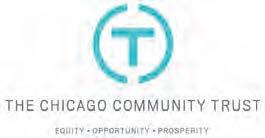
SPRINGBOARDS TO
CAREERS

Before Leyla Spells became a registered nurse, one major obstacle stood in her way: the National Council Licensure Examination, a standardized test she needed to pass. Spells had taken the exam three times, failing to answer the minimum number of questions correctly—spending hundreds of dollars each time to retake it.
tutoring startup New Nurse University. She eventually took one-on-one tutoring from the company’s founder, Renee Dyson, a registered nurse herself. And Spells went on to pass the exam.
“Honestly, I give 85-95% of that (credit) to Renee,” Spells says.
BY TATIANA WALK-MORRIS
Re ecting on her experience as a student at Northwestern College, a for-pro t school that recently moved from suburban Bridgeview to Oak Lawn, Spells says she doesn’t think her education there was up to par. After struggling to pass the licensure exam, she came across a Facebook group for Black nurses and learned about Chicago-based
Spells isn’t alone in looking beyond the higher education system for help reaching a career goal. As America reckons with its student debt crisis, career readiness programs have emerged to shepherd high school and college students into jobs that will allow them to achieve nancial stability and build

CRAIN’S CHICAGO BUSINESS • DECEMBER 19, 2022 23
CRAIN’S CHICAGO BUSINESS
CAREER READINESS SPONSORS
Readiness programs emerge to shepherd high school and college students into jobs that open a path to nancial stability and wealth-building
Renee Dyson, a registered nurse, founded New Nurse University to help people pass the national licensure exam.
See CAREERS on Page 24
JOHN R.BOEHM
CAREERS
CAREER READINESS
wealth, especially among people who would otherwise be excluded from higher education. ese programs complement or serve as an alternative to higher education as many students from marginalized backgrounds search for less expensive pathways into their desired industry or seek assistance not all colleges and universities can suciently provide.
Dyson launched New Nurse University in 2016 to help nursing students enter the eld. She says her company has helped more than 1,500 students continue their nursing studies and pass the NCLEX. Most of the students who’ve come to her are women and people of color, and some of her students are working in programs that don’t have tutoring services to help them master their studies, she says.
Nursing students “may not have a teacher that looks like them. ey may not have the tutoring service available to them outside of when the nursing program closes for the day,” Dyson says. “Our service is providing . . . mentorship to the students to stay in their programs, and we’re bridging the gap like that.”
Spells graduated from Northwestern College with about $30,000 in student debt. Now that New Nurse University helped her pass her exam, the 26-year-old mother of two is living and working in Chicago as a travel nurse. She sees nancial exibility in her future: debts paid o , a home of her own, international travel, money for her children’s education. She’d like one day to open a school to train certied nursing assistants.
Retiring student loan debt is another obstacle for former students like Spells. A 2022 Education Trust analysis found that Black women hold the most student loan debt a year after earning their undergraduate and graduate degrees. Black women hold $38,800 in student debt on average a year after graduating with undergraduate degrees, more than the average for Black men ($35,997), Indigenous/Alaska Native women ($32,619), multiracial women ($28,628), white men ($24,348), Latinas ($25,927), Latinos ($26,582), Asian women ($20,417), white women ($27,068) and Asian men ($20,829).
And while Black women have average student debt of $58,252 a year after earning graduate degrees, Black men have $49,416 on average, followed by multiracial women ($43,984), Latinas ($40,185), Latinos
($31,971) Indigenous/Alaska Native women ($36,795), white women ($29,323), white men ($25,905), Asian women ($21,180) and Asian men ($9,913), the analysis found.
Career readiness programs are helping students nd jobs without incurring debt, and they show some promise in addressing the racial wealth gap, too, because they enable students to learn and immediately apply their new skills at jobs.
e programs’ success depends on having strong job placement and helping students learn the soft skills that will help them succeed in the workplace, says Jenny Nagaoka, deputy director at the University of Chicago’s Consortium on School Research, which conducts research to inform and assess policies and practices at Chicago Public Schools.
Skills such as “showing up on time, collaboration skills, communication skills, being able to work through struggles and problems— these are things that are valuable in college, they’re valuable at work,” Nagaoka says. “ ose are sort of like universal things that matter a lot.
at these programs are structured in ways that are sort of designed to support this can be really e ective.”
CIRCUMVENTING STUDENT DEBT
With the fate of President Joe Biden’s student debt cancellation e orts in the hands of the Supreme Court, programs like that of Per Scholas, a multistate nonpro t that trains students for tech jobs, are helping students avoid debt and get their foot into the door of potential employers. e organization o ers courses on cybersecurity, software engineering and Amazon Web Services. It set up its Chicago location in June 2020.
In addition to the technical training, Per Scholas does weekly professional development classes during which students craft résumés, create LinkedIn pro les and practice doing remote and in-person job interviews. For students who need additional assistance in times of need, the organization also provides emergency funds for those in crisis, gives Lyft rides to job interviews and connects students with a guidance counselor in times of di culty, says Andi Drileck, managing director of Per Scholas’ Chicago o ce.
e majority of the students Per Scholas serves are people of color, and about a third are women. So far, the Chicago o ce has trained
250 technologists, a spokesperson for the organization con rms.
“We’re trying to diversify the tech sector. Sometimes it feels like baby steps, quite frankly,” Drileck says. “We’re making a big e ort, but there is a really long way to go.”
For Taleya Gri n, the diversity of Per Scholas was particularly appealing. While studying information technology at the University of Cincinnati, Gri n says many of the people in her program did not look like her, but she saw plenty of other students of color at Per Scholas, where she received training in user desktop support.
Gri n enrolled in Per Scholas in July after her grandmother got sick and she decided to return to Chicago. And after working for FedEx for about a year, she found Per Scholas was the pathway for her to get back into tech. She heard about the program on TikTok.
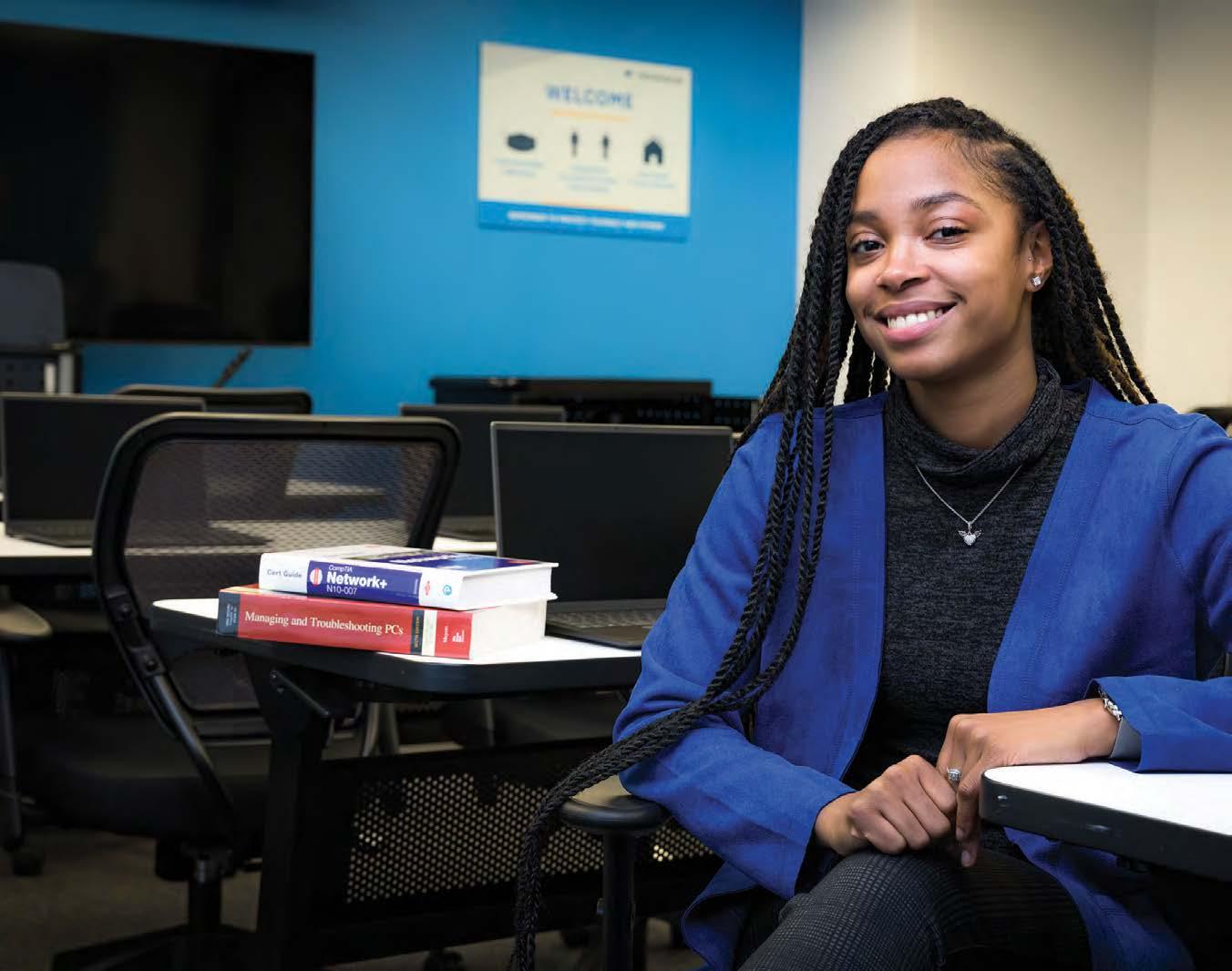
After completing the program in October, she is set to start a new job at DTI, an IT consulting and networking rm, as a junior analyst consultant in the company’s apprenticeship program. In the long term, she wants to help her peers get exposure to di erent career paths, because she wasn’t aware of her full career prospects until she went away to college, she says.
Now that she has her new job,
the 21-year-old Auburn Gresham resident says she looks forward to having a manageable schedule that will let her do the things she enjoys, particularly roller skating. Why roller skating? “Because I get to feel the air, I get to feel free,” Gri n says. “I can be happy because before I was always guring out what was next. . . .Now I could do what I want to do. Like, if I want to go skating, I can incorporate that within my day. If I want to work out, I can put that in my day.”
A START AT CLOSING GAPS
Alongside organizations looking to help women and people of color, Ada S. McKinley, a nonpro t providing employment, family and community services in Chicago, Wisconsin and Indiana, assists people with disabilities to nd jobs. e organization also recently received an American Rescue Plan grant to assist and train young Chicagoans, says Eric Edquist, senior vice president of employment and community support services at Ada S. McKinley.
Following the COVID-19 pandemic, some companies have recognized the value of workers with disabilities, Edquist says. e nonpro t doesn’t share job seekers’ personal information with employers, but they try to prepare the employee for the job upfront
24 DECEMBER 19, 2022 • CRAIN’S CHICAGO BUSINESS
CHICAGO BUSINESS
CRAIN’S
Continued from Page 23
“WE WORK PROACTIVELY TO ELIMINATE BARRIERS TO EMPLOYMENT AND TO ADDRESS THE CAUSAL FACTORS THAT ARE UNDERLYING THE SOCIOECONOMIC DISPARITIES AND INEQUITIES OF ACCESS AND GRADUATION (IN) HIGHER EDUC ATION.”
Stacia Edwards, deputy provost, City Colleges of Chicago
Taleya Gri n landed a career in technology after completing Per Scholas professional development classes.
so that they can thrive.
“What we’ve seen is people with disabilities being really consistent with work, falling in lines with the company culture,” Edquist says. “We hear many more positive things than negative things.” e organization hosted a job fair in October during which it brought in employers such as the Greater Chicago Food Depository, Roosevelt University and the Chicago Urban League. It has 25 contracts with state, federal and commercial entities to provide custodial maintenance, Edquist says.
“I think we’re at the start of closing wealth gaps,” Edquist says. “And one of our goals is working with people to be employed just to meet basic needs. ere’s de nitely value in self-dignity, self-worth of having a job and contributing to an employer or our economy or our country. But a big part of our goals with this is people being able to meet basic needs of having a home, purchasing a winter coat, things like that.”
For Keisha Hollins, working with Ada S. McKinley to get a job as a quality control associate was a key to coming out of her shell. She was placed in special education classes during high school, which came with a stigma. As a result, she had a hard time opening up to people without feeling like they were going to cause her distress, she says.
After that experience, nding Ada S. McKinley “helped me grow throughout the years. It was kind of hard for me to be around people,” Hollins says. “And so Ada S. McKinley helped me to develop good communication and people skills.”
PIPELINE FOR EMPLOYERS
For employers, career programs o er a pipeline to up-and-coming talent among high school and college students. Citadel and Citadel Securities teamed up with rive Scholars to launch two programs: the Citadel Securities Externships, a two-week program for college sophomores and seniors, and the rive Summer Academy, a six-week program for college freshmen.
As part of the programs, Citadel provides training that covers skills from résumé writing and learning math to mastering Python—a high-level programming language—and HTML, as well as mentorship from the rm’s employees. For Citadel, the collaboration adds another pipeline of students who may have an interest in nance and who wouldn’t otherwise be exposed to the industry, says Matt Jahansouz, chief people o cer at Citadel.
“We have a strong pipeline of talent, but to the extent that we could feed that with a new channel, we were all about it. And we realized getting to those students as early as possible is going to be an important part of that strategy,” Jahansouz says.
David Opoku-Ware, a sophomore at the University of Illinois Urbana-Champaign, says he enjoyed connecting with Citadel employees, its hospitality and housing, and meeting other students.
“I’ve kind of opened my eyes up to careers in a business world ornance world just because I’ve never really looked into that or seen that as a career path for myself. e only thing I’ve known about business or the closest thing I’ve known to it is ‘Shark Tank.’ I didn’t know what business entails. What goes on? Is it like a feasible career? Seeing how it overlaps with technology especially made me want to look more into pursuing a career in that.”
Similarly to nonpro t career readiness programs, City Colleges of Chicago has many students of color who will be the rst in their families to graduate college. In recent years, City Colleges has launched programs like the Fresh Start initiative, which eliminates the education debts of former City Colleges students who want to return to their studies. Besides the training needed to nd or change jobs, City Colleges also provides clothing for people interviewing for jobs, résumé preparation and other career counseling for students.
“We work proactively to eliminate barriers to employment and to address the causal factors that are underlying the socioeconomic disparities and inequities of access and graduation (in) higher education,” says Stacia Edwards, deputy provost of City Colleges of Chicago. “We’re a community college, and so I really believe that that’s why we’re here . . . because we are accessible.”
Career programs could use more funding, leaders say
Program leaders seek to go beyond training marginalized students. They want to assist them in overcoming systemic inequities blocking their progress.
BY TATIANA WALK-MORRIS
Following its 2020 launch in Chicago, Per Scholas, which trains students for tech jobs, now has a waitlist for some of its Chicago classes, says Andi Drileck, managing director of Per Scholas’ Chicago o ce. Money is the biggest factor preventing the organization from o ering more classes, she says.

“What an opportunity it would be in Chicago to be able to expand our resources so that more people can take advantage of this, and then the workforces can get diversi ed and the shortage of tech workers can be lled,” Drileck says.
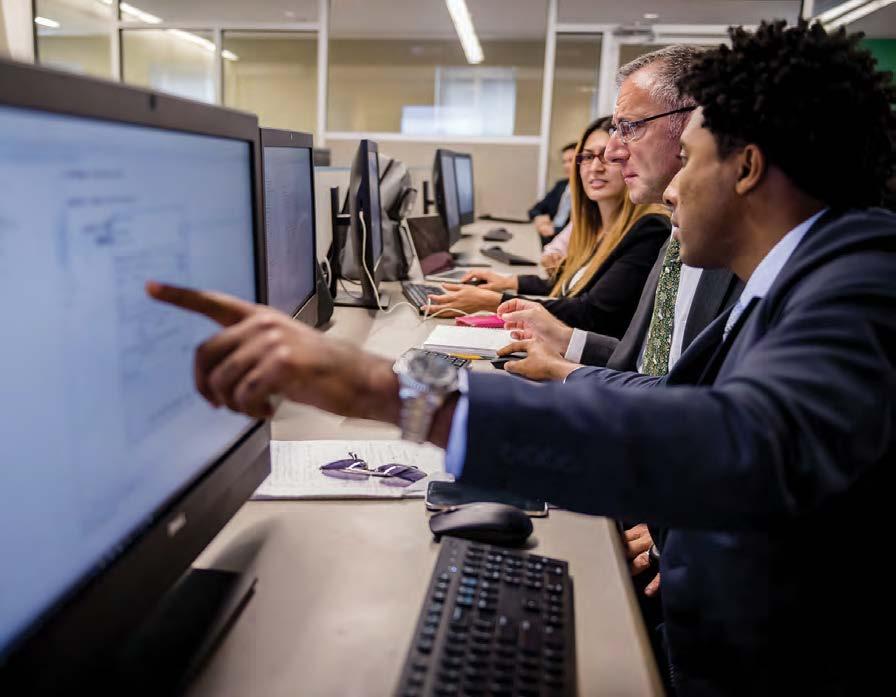
For career readiness programs preparing students for their next move, doing so requires substantial support from companies, particularly nancially and in terms of having open positions. With the limited resources they have available, career readiness programs are trying to go beyond training marginalized students for their future careers to also assist them in overcoming the systemic inequities interfering with their progress.
Eric Edquist, senior vice president of employment and community support services at Ada S. McKinley, a social services nonpro t serving people in Chicago, Wisconsin and Indiana, notes that the organization could use
more funding to support its numerous services, which include tutoring, counseling, employment training and Head Start programs. And when working with employers who are seeking to hire people with disabilities, it’s also helpful when those employers support the organization’s e orts to prepare the employee before starting their job.
“When (employers) allow us to do that, they’re patient and they de nitely start seeing the value of the person’s adding— the results down the road are fantastic,” Edquist says.
For Renee Dyson, a registered nurse and founder of tutoring service New Nurse University, the grant she recently received from New York-based business consulting rm Next Street will enable her to hire at least two more people to help her run her company.
New Nurse provides mentorship and tutoring to nursing students seeking help with passing their National Council Licensure Examination.
“In addition to my self-serve on-demand library, now I really want to have tutors and sta that help me with the back end of the business,” Dyson says. “I want an a liate program where the
students can refer and get paid to put money in their pockets. I’m just trying to do everything.” As much as career readiness programs try to help students reach their career goals, they’re also combating challenges outside of the classroom. Jenny Nagaoka, deputy director at the University of Chicago’s Consortium on School Research, points to City Colleges of Chicago and the University of Illinois Chicago as examples of institutions that are trying to support students outside of the classroom.
“ ere’s still a lot more work to be done, but there’s an understanding that this is a problem that they need to be grappling with,” Nagaoka says. “Colleges and high schools can be a piece of the solution, but at its root, they’re putting a Band-Aid on a much larger
problem. And if they do want their students to succeed, they need to be doing everything they can to be positioning their students to be successful.”
CRAIN’S CHICAGO BUSINESS • DECE M BER 19, 2022 25
JOHN R. BOEHM
PER SCHOLAS
Per Scholas learners engaged in an IT Support training cohort.
“COLLEGES AND HIGH SCHOOLS CAN BE A PIECE OF THE SOLUTION, BUT AT ITS ROOT, THEY’RE PUTTING A BAND-AID ON A MUCH LARGER PROBLEM.”
Jenny Nagaoka,
deputy director
at the University of Chicago’s Consortium on School Research
Training urban farmers lls a growing need
As winter arrives in Chicago, it’s easy to think that there is nothing happening at local farms and gardens, with plants gone and only bare soil remaining. But ask a farmer, and they will tell you there is essential work happening underneath that soil, with thousands of insects and bacteria teaming together to prepare the way for future plantings.
When you look at the inequalities in our food system, it is easy to feel that same restlessness, a sense of not enough meaningful e ort.
But that hard work is happening. You see it in the smart, resilient and hardworking individuals who are part of Windy City Harvest, the Chicago Botanic Garden’s urban agriculture education and jobs-training initiative. is is the next generation of farmers, and as the program director for Windy City Harvest, I am happy to tell you that the future of urban farming in Chicago is very bright.
Urban farming is more than access to local food. It is workforce development, a continuum of education and community partnerships that create opportunities in the
 COLLECTIVE EFFORTS
COLLECTIVE EFFORTS
very neighborhoods where beginning farmers work, and live.
ose gardeners, and their communities, need the right tools.
Since 2002, Windy City Harvest has developed comprehensive programs focused on food, health and jobs throughout Chicago, from Lawndale to Bronzeville. at means these community members have access to youth development, workforce training and job placement, entrepreneurship training, farm business opportunities and quality fresh produce.
at proximity matters. Windy City Harvest programming provides paid, on-the-job training for more than 150 people every year, with an average of 80% placement rate in food systems jobs post-training. And some of those new farmers have taken it a step further: 25 small farm businesses got their start at Windy City Harvest.
Many participants are introduced to Windy City Harvest through our transitional job training program, called Corps, which employs 30 to 40 justice-involved individuals and veterans in closely mentored, full-
time, paid transitional jobs, and supports them in nding full-time, long-term employment annually.
I see graduates from our Corps program, who started working with us because they were looking for a job, nd a passion for urban farming. ese future farmers are dedicated to bringing healthy food, the beauty of nature and high-quality jobs to our city. It gives me so much hope for the future of our local food systems.
Here’s what one Corps program graduate who is moving on to our Apprenticeship program, a hands-on, technical training in sustainable urban agriculture o ered in partnership with the City Colleges of Chicago, said:
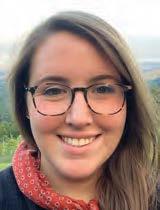
“I was looking for something new but something that felt familiar. is program
was perfect because my granddad used to farm and do this type of work. It feels like it’s meant to be. He passed away a few years ago. Now here I am carrying on the legacy. It’s just a blessing to be able to take care of yourself and your family and I hope to continue to learn more.”
Windy City Harvest has seen rsthand how education leads to bigger opportunities. Many of our Corps and Apprenticeship program participants are able to build upon their training and enroll in the Incubator program, which supports beginning farmers in Chicago with access to land, tools, water and networking as they begin their small businesses.
People are at the center of Windy City Harvest. And all of their successes started with a very necessary tool: the opportunity.
A major step toward closing the racial wealth gap
The persistent racial wealth gap in the U.S. continues to be a burden on Black and Brown Americans, as well as the overall economy, according to a study by McKinsey. It is estimated that its dampening effect on consumption and investment will cost the U.S. economy $1.5 trillion over the next decade.
Even worse, if no action is taken to address this, communities of color are on a pathway to hit zero median wealth in the coming decades—estimated by 2053 for Black households and 2073 for Latinx households, per Federal Reserve data.
While there is no simple solution to closing the racial wealth gap, one critical rst step is committing to providing opportunities for career readiness for our disinvested communities.
Kathleen St. Louis Caliento is president and CEO of Cara Collective, a 32-year-old workforce development enterprise based in Chicago that has placed people experiencing poverty into more than 13,000 jobs.

For more than three decades, Cara Collective has worked primarily with individuals and communities that have historically and systemically been left without access to opportunities for gainful employment.
Primarily, we work with Black and Latinx individuals (more than 93% of our participant population) from our South and West Side communities (North Lawndale, Englewood and Austin among the top).
We prepare individuals for careers through a combination of training that focuses on both professional skills-based readiness as well as socio-emotional wraparound support services. is helps our job seekers achieve long-term on-the-job success. roughout our history, we’ve been able to place people experiencing poverty into more than 13,000 jobs, with a one-year career retention at more than 20 points higher than similar workforce programs.
rough this work, we’ve learned that if we are to really prepare individuals for gainful employment successfully, it requires partnership and collaboration.
As part of our model, we work with dozens of organizations and leading companies in a multitude of industries to provide career
opportunities. ese unique partnerships are a leading factor to our success in job placements, and yet, in recent years, we’ve asked ourselves an important question— what would it take to catalyze these partnerships to create an even deeper, more-lasting systemic impact?
Recently, Cara Collective launched our three-year strategic plan, “Access. Equity. Opportunity.” A key priority of this is to better leverage our partnerships (new and old) to create more inclusive career pathways and close the racial wealth gap in Chicago and beyond.
We’re doing this by working with employers on creating branded trainings, designed to give job seekers the skills and certi cations to become more market-competitive. We’re doing this by working with companies to examine how to make their hiring practices more inclusive. And we’re doing this by working with other social-purpose organizations to create e ective workforce development solutions.
One such partnership illustrating the success of this is our collaboration with BMO Harris on BMORE. Launched in late 2020, BMORE is designed to increase access to employment in banking and nance. Re-
cruitment for BMORE focuses primarily on the Austin and Little Village neighborhoods in support of Mayor Lori Lightfoot’s Invest South/West initiative, which addresses economic disparity in key neighborhoods.
Two years in, BMORE is responsible for the creation of more than three dozen jobs in Chicago for individuals who previously felt excluded from careers in banking. Additionally, we continue to work with BMO Harris to ne tune and evolve the program to better meet the needs of job seekers based o observations and feedback received from them. e success of this is evident in the fact that BMO Harris has launched BMORE in two additional Midwest markets in 2022.
Preparing for and developing pathways to gainful employment for our Black and Brown communities is a critical step in solving the racial wealth gap. But creating lasting impact requires an investment from all of us—both in the individuals, and the ripple e ect that happens as they achieve nancial stability; and at the systems level by working with some of the largest national Fortune 500 companies. By bridging the gap between the two, only then can we begin building a stronger, more inclusive economy.
26 DECEMBER 19, 2022 • CRAIN’S CHICAGO BUSINESS
CRAIN’S CHICAGO BUSINESS CAREER READINESS
ON-THE-JOB
Britt Calendo is the program director of Windy City Harvest at the Chicago Botanic Garden.
CHICAGO BOTANIC GARDEN
A model focused on removing hiring roadblocks
For decades, the underlining theory of using workforce programs and government funding to address unemployment has been based on an outdated approach: By training workers, we prepare more of them for jobs and bring down high unemployment rates. Last year, the U.S. government spent $55 billion on workforce programs, yet millions of Americans remain unemployed and employers struggle to find quality talent.
ese time-intensive workforce programs clearly haven’t met the needs of employers or job seekers, particularly job seekers in Black and Brown communities where unemployment rates remain stubbornly high and well above national averages.
Ten years ago, the founders of Skills for Chicagoland’s Future recognized that we need a new approach. Skills has endeavored to ip the traditional method of solving unemployment on its head. Instead of training for jobs we hope people will be placed in, Skills starts with the jobs rst, learning about the hiring needs, company culture and long-term goals of our corpo-
rate partners and connecting them with talented, unemployed job candidates whom Skills has helped coach and prepare.
Every year, Skills works closely with community organizations and recruits thousands of job candidates by focusing on their skills and by overlooking traditional hiring roadblocks, such as education requirements that have led to a historic lack of opportunity in Chicago’s Black and Brown communities.
With only 35.5% of Illinois residents holding a four-year degree, there are millions of people being excluded from roles they would be successful in because of outdated hiring practices.
Our jobs- rst approach has been a proven success. In the 10 years since our founding, Skills has placed nearly 11,000 unemployed and underemployed individuals into quality jobs and career paths and expanded our operations to better serve the South and West sides of the city. With one site already established in Rhode Island, Skills is also working to expand nationally
to bring its unique model to 25 new cities over the next decade.
e corporate world has taken notice. Skills has grown its partnerships with 130 corporations and is immensely proud of the personal stories of our success. Job seekers hired for entry-level roles have grown them into careers of their own, putting the days of living paycheck to paycheck behind them, building their own wealth and serving as a valued member of their employer’s team and mission.
But there is much more work to do. Last year, data showed there were over 380,000 jobs available nationally with the country’s top 25 Fortune 500 companies that advertised less than a college degree. By increasing partnerships with these companies, Skills can act as the bridge between jobs and talented workers. e impact on economic mobility and recovery for people across the country would be unparalleled.
support from Skills. e bank knows that the Skills model works, which is why it has recognized us with its signature philanthropic award—the Neighborhood Builders award.
e Neighborhood Builders program infuses both funding and leadership development into nonpro t organizations committed to advancing economic mobility. Since the program’s inception, Bank of America has invested over $280 million in more than 1,400 nonpro ts and helped more than 2,800 nonpro t leaders strengthen their leadership skills. In Chicago, that translates to $7.4 million in funding for 38 nonpro ts, including Skills.
LAST YEAR, THE U.S. GOVERNMENT SPENT $55 BILLION ON WORKFORCE PROGRAMS, YET MILLIONS OF AMERICANS REMAIN UNEMPLOYED.
Our corporate partners can attest to the success of our approach. One of those partners is Bank of America Chicago, which has bene ted from the placement of more than 60 full-time employees since 2015 with
At a time when all of us are called to do better by breaking down historic inopportunity in our society, if corporations are truly committed to change, we must start with re-evaluating the systems that created the inequities in the rst place—and working toward real, lasting change.
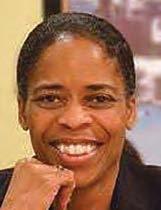
CRAIN’S CHICAGO BUSINESS • DECE M BER 19, 2022 27
MUTUAL INTERESTS
Pam Tully is the chief program o cer at Skills for Chicagoland’s Future
NEARLY 70% OF CRAIN’S AUDIENCE READ TO STAY INFORMED ABOUT INDUSTRY LEADERS Showcase Industry Leaders and Their Careers RECOGNIZE TOP ACHIEVERS IN CHICAGO’S PREMIER PUBLICATION PROMOTIONS SPECIAL ACKNOWLEDGEMENTS BOARD APPOINTMENTS NEW HIRES RETIREMENTS MAKE AN ANNOUCEMENT! Debora Stein | dstein@crain.com
THE FUTURE OF WORK
Creating a more exible work landscape with technology and innovation



A widespread disruption is underway in the form of hybrid work: While some organizations have insisted that workers return to the of ce full-time, many have transitioned to a new normal where employees spend some days in the of ce and some days working remotely, with a combination of virtual and in-person meetings and collaboration.
MARK REISENAUER is President of Astellas Pharma US, a $5 billion af liate of the Tokyo-based pharmaceutical company headquartered in Northbrook, Ill., with 1,000 employees. Astellas is a company committed to improving the health of people around the world through the provision of innovative pharmaceutical products.
MARK REISENAUER President Astellas Pharma
US
Reisenauer has dedicated his career to creating change that positively impacts the lives of patients and their caregivers. Over the past decade, he has helped establish Astellas as a top 25 global pharmaceutical company and build the oncology franchise, which is the company’s fastest growing franchise.

Reisenauer also serves on the board of the Pharmaceutical Research and Manufacturers of America (PhRMA), an organization dedicated to advancing policies that ensure continued investment in biopharmaceutical innovation.




CRAIN’S: Why did Astellas choose to adapt its Ways of Working and transition to a hybrid work environment?

MARK REISENAUER: As COVID-19 cases were on the rise, Astellas quickly adopted di erent working arrangements to ensure the health and safety of employees, while still allowing them to be fully
functional in their roles. Recognizing that we needed to transition from merely accommodating exibility (in response COVID-19 guidance) to developing a philosophy and strategic framework that supports long-term exibility, we adjusted our Ways of Working philosophy to transition to a hybrid work environment. It’s something we continually evaluate at Astellas as we work to deliver the best
outcomes for our patients, customers, partners and other stakeholders, while also supporting the diverse needs of our employees.
CRAIN’S: How did you leverage lessons learned from the pandemic to create a Ways of Working philosophy that enables long-term exibility for employees?
REISENAUER: Although we encouraged open and transparent two-way dialogue between leadership and employees before the pandemic, we knew the hybrid work environment required more than simply having an “open door” policy. We created new virtual channels for employees to share their needs and ideas, so that we could better support their well-being. For example, employees wanted to hear from our leaders directly more frequently and informally. So, we reimagined the large, formal, in-person town halls we used to have in the o ce and now host smaller, more frequent hybrid gatherings.
CRAIN’S: How does Astellas build connections and foster collaboration among employees in a hybrid environment?

Building connections and collaboration can happen in many types of virtual and in-person environments. However, I’m particularly proud of the quarterly inperson events that we’ve been hosting at our Northbrook o ce. In our most recent event, we focused on giving back and partnered with two local charities to host events with handson activities. It was a great way for employees to volunteer together and build new relationships. We are also considering more frequent target days and times to bring our employees back to the o ce together.
CRAIN’S: Within the hybrid work environment, how much value do company leaders and employees place on opportunities for in-person/faceto-face interaction?
REISENAUER: Face-to-face, real-world interaction is incredibly important in creating moments for collaboration and innovation, while building relationships and strengthening company culture. Successful companies will nd ways to balance the bene ts of personal exibility with the bene ts of in-o ce interactions. While I can’t speak for everyone, I know I’m especially energized when I’m in the o ce with colleagues as I appreciate the collaboration and adhoc conversations that are typically more challenging in a virtual setting. In the year ahead, I want to create more opportunities for employees to engage in-person and have meaningful moments together that strengthen relationships and connections across the organization.
CRAIN’S: How does your culture help to create a more diverse and inclusive company?
REISENAUER: Fostering a diverse and inclusive workplace and o ering employees unique networking and learning opportunities remains a top priority. We empower our employees to establish inclusive support communities within the company and are proud to currently support seven dynamic employee impact groups (EIGs). Our EIGs enhance our ability to meet the needs of employees, patients and communities. Each EIG is led by a team of employee volunteers and an executive sponsor that focus on driving impact by aligning their objectives to four key pillars: career, culture, community and commerce. I was the executive sponsor for the Hispanic EIG, and in that time, we developed small group breakfast forums to facilitate networking and peer support. e ideas from our EIGs and e ort to support the growth of our employees is incredible.
CRAIN’S: What challenges have you faced in your hybrid work environment and what solutions did you put in place to address them?
REISENAUER: One of the biggest challenges we face in our hybrid work environment is how to make and maintain meaningful connections. We have introduced several internal engagement campaigns for our employees to share their day-to-day activities in a casual environment in the same way they would by gathering at the water cooler or cafeteria. We also regularly survey our employees to understand how they view our culture and ways of working and where it can be improved. To this day, we continue to evolve and consider new ways that will be even more e ective at bringing us together.
CRAIN’S: How do your employees feel about your Ways of Working philosophy?
REISENAUER: We’re proud to consistently earn places on several top employer lists in a variety of areas, including LGBTQ equality, support for working parents, environmental sustainability, female empowerment, military support and more. Not only are these accomplishments a testament to the collaborative, innovative and inclusive culture that we foster, but they also show that our employees feel valued and empowered to do their best work. We continue to enjoy the bene ts of working in a hybrid work environment, with a mix of time spent in the o ce and working remotely. As we moved through the di cult months of the pandemic, we also boosted our employee health and well-being programs and we’ve continued to improve our bene ts based on new insights and feedback. Altogether, this helps us grow careers at Astellas and attract new, diverse talent.
CRAIN’S: How do you see hybrid work evolving in the next three to ve years?
REISENAUER: First, I think it’s important to recognize that not all companies and industries can o er a hybrid work environment, such as frontline healthcare workers, doctors and nurses who never stopped going into work and caring for their patients face-to-face every day. For companies like Astellas that can o er a variety of work options — virtual, hybrid, in-o ce — we must continue to listen to the needs of employees and evolve how and where we work accordingly. I believe hybrid work is here to stay, and we need to create adaptable organizational structures that blend virtual and in-o ce work opportunities and rede ne company culture in new ways as the environment continues to transform.
LEADER REPORT
KRISTIN E. MICHAELS
Partner
Labor & Employment practice group
kmichaels@nge.com (312) 269-8475

aspects of labor law, including unfair labor practice litigation, strikes and injunctions, collective bargaining negotiations, Section 301 litigation, mergers and acquisitions, and arbitrations.



She has handled hundreds of cases involving claims of harassment and discrimination, wage and hour violations, and breach of restrictive covenants.
She has litigated cases involving the gamut of labor and employment issues, from Title VII of the Civil Rights Act through the Fair Labor Standards Act and encompassing assorted state and federal statutes.
She also routinely provides legal counsel with respect to company investigations of claims of harassment and discrimination. Kristin previously served as a Chief Legal Counsel at a national media company.
CRAIN’S: What challenges have you seen employers facing with hybrid work?
KRISTIN E. MICHAELS: It’s two-fold: interpersonal employee relationship and compliance.
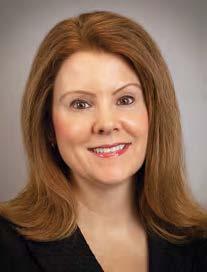

Challenges facing employers have included: integrating new employees; providing an opportunity for employee training and mentorship; fostering the development of interpersonal relationships and a
restrictions; worker’s compensation and unemployment compensation requirements; state and local tax obligations; PTO carryover and payment of PTO upon termination obligations; anti-harassment and anti-discrimination training requirements; employment law notice requirements; and varying rules regarding the enforceability of restrictive covenants such as noncompetition agreements.

topics as varied as hobbies, sports, books, and workplace questions and assistance.
Concerning the potential compliance challenges of remote workers, employers have become more diligent about tracking the locations of their remote employees and the associated state employment and tax law and licensure requirements. Employers are also dra ing policies speci cally covering remote work issues. In some


cases, employers restrict the states from which employees may work.
CRAIN’S:
MICHAELS: There are a few ways. Some employers are turning to employee time tracking tools, such as mobile time clocks on smartphones, to accurately track employee time and to ensure employees take required meal and rest breaks. A virtual onboarding process, which automates the typically timeconsuming onboarding tasks and allows remote and other new hires flexibility as to when and where to complete these tasks, has become a necessary and widely used tool in the flexible work landscape. More employers are embracing document management tools, such as Google Workspace, that allow for employee collaboration on and review and editing of company documents and presentations without being in a physically shared space. Workflow management tools have also increasingly replaced in-person status and organizational meetings.
MICHAELS: Update your employee handbook or prepare workplace policies that address issues unique to hybrid and remote work so that employees understand expectations. These policies should cover, among other things: remote timekeeping; application of antidiscrimination and anti-harassment policies to hybrid and remote work environments; reimbursement of expenses for telecommuting; worker’s compensation guidelines for working from home; maintaining the confidentiality of company documents and data; and IT security requirements. Update offer letters and other employment documents that specify the location from which an employee will work. Be diligent about tracking where employees work and understand what state and local laws may apply to these locations. Ensure that hybrid schedules do not appear to discriminate against employees on the basis of race, disability, age, sex, or any other protected status.
sense of belonging; and replicating the type of impromptu discussion and collaboration that naturally occurs in an in-person work environment.
Employers also face challenges when employees work remotely from locations other than the employee’s assigned o ce location. Multiple locations may subject the employer to out-of-state laws, leading to additional and potentially burdensome compliance issues. Among the potential issues that may arise are: di erent wage and hour requirements, such as daily overtime, higher minimum wage laws, and di erent meal and rest break requirements; di erent paid leave requirements; new or di erent expense reimbursement requirements; background check

CRAIN’S: How are employers addressing these challenges?
MICHAELS: Understanding the importance of training, mentorship, collaboration, and fostering interpersonal relationships in the work environment, some employers have been deliberative about structuring their hybrid workplaces. We have seen employers require that teams, groups, or departments have the same hybrid schedule to ensure that employees are in the workplace on the same days. Others have proactively established virtual “water coolers” where employees can interact spontaneously or otherwise. Employers may assign employees to these virtual forums or simply make them available to employees to discuss both work and non-work
How are Employers using technology to meet a more exible work landscape?
CRAIN’S: What recommendations would you give employers as they navigate a hybrid work structure?
Working with a Partner You Can Trust To learn more, visit: nge.com/laborandemployment Our nationally recognized labor and employment team provides insightful guidance to corporate decision-makers as they prepare today for tomorrow’s success. We collaborate with our clients to identify the challenges of the future workplace and design solutions to serve their businesses while benefiting their most important resource employees. KRISTIN MICHAELS is a partner in the Labor & Employment practice group. She focuses her practice on labor and employment law and has extensive experience in labor relations, employment litigation, employment advice and counseling, and mergers and acquisitions. She has handled all
“UPDATE YOUR EMPLOYEE HANDBOOK OR PREPARE WORKPLACE POLICIES THAT ADDRESS ISSUES UNIQUE TO HYBRID AND REMOTE WORK SO THAT EMPLOYEES UNDERSTAND EXPECTATIONS. — KRISTIN E. MICHAELS, NEAL GERBER EISENBERG SPONSORED CONTENT
Crain is looking for a Digital Analytics Manager to join a growing Data & Analytics team. We support all the Crain brands (AdAge, Automotive News, and Crain’s Chicago—among others) with actionable intelligence that helps drive revenue and grow the business. The team is responsible for mining our various data sources to generate actionable insights that increase subscriber engagement, drive higher conversion rates, increase loyalty, and create new revenue opportunities. Join a team that’s constantly identifying ways to leverage our best-inclass content to continue the expansion of our fast-growing subscription business. Visit crain.com/careers/
Walgreens’
Michigan’s Ross School of Business. “Going into delivering primary care—that’s not an easy business.”
Executive Chairman Stefano Pessina launched the project before turning over the CEO title to Roz Brewer in 2021. With pro ts and revenues in its traditional business under pressure, Walgreens needed new sources of growth.
Walgreens wants to change the way Americans get health care, offering easier access and lower costs than traditional service channels. With about 78% of U.S. households living within 5 miles of a Walgreens store, the company could become the go-to primary care provider for millions of people.
“Our goal is to invest and expand on solutions that allow us to deliver a lower total cost of care,” says John Driscoll, the newly appointed executive vice president and president of Walgreens’ health care segment. “We and Village are working to target the highest-need geographies where we think we can get relevant physician scale.”
A successful transformation could give Walgreens a lucrative new position in health care, an enormous industry that’s growing faster than the economy as a whole. Failure would leave the company weakened and burdened with a heavy debt load incurred in part to nance the transformation.
As Walgreens moves ahead, it will need to meet challenges ranging from recruiting doctors to establishing specialist relationships and navigating byzantine health care payment systems. Walgreens also faces competition from established health care players, as well as newer entrants, including its longtime pharmacy rival CVS Health.
Among the many unknowns is whether the new business model will generate acceptable returns on the billions Walgreens is pouring into it. In addition to paying $6 billion for a majority stake in VillageMD, Walgreens has spent $6.5 billion over the last two years to buy post-acute and home care rm CareCentrix and specialty pharmacy Shields Health Solutions, and to nance VillageMD’s
acquisition of primary care company Summit Health-CityMD.



Driscoll and Brewer must integrate this conga line of new assets with each other and the company’s existing network of more than 8,800 U.S. stores, adding to the complexity of the project. And Walgreens isn’t done with acquisitions. Brewer recently told Wall Street analysts that she’s looking to buy a health care technology company.
LINCHPIN
While VillageMD remains a stand-alone company, analysts say Walgreens’ success in health care depends largely on growth and pro ts from the primary care provider.

“We believe the linchpin of the strategy is solid margin improvement in VillageMD clinics as they scale and mature,” Deutsche Bank analysts wrote in an Oct. 24 report.


After the Summit deal in November, Walgreens raised its U.S.
2025 health care sales goal to $14.5 billion to $16 billion, up from $11 billion to $12 billion. at’s about 12% of Walgreens’ overall 2022 sales of $132 billion.
In the fourth quarter, the company’s U.S. health care business unit lost $37 million on $622 million in sales, with Shields and VillageMD growing by 48% and 31%, respectively. But Driscoll predicts the business will turn pro table by scal 2024.
“We’re committed to improving the return for our shareholders,” says Driscoll, who joined the company after Walgreens acquired CareCentrix, where he was CEO.
Investors have yet to show much enthusiasm for Walgreens’ metamorphosis. As of Dec. 16, the company’s stock was down more than 25% for the year, while the S&P 500 had dropped 19% and CVS had lost more than 7%.
30 DECEMBER 19, 2022 • CRAIN’S CHICAGO BUSINESS CLASSIFIEDS Advertising Section To place your listing, contact Suzanne Janik at (313) 446-0455 or email sjanik@crain.com .www.chicagobusiness.com/classi eds Follow Our Victories ! DADS’ RIGHTS! LAW AUCTIONS advertising opportunities available To advertise contact Suzanne Janik at sjanik@crain.com (313)
CAREER OPPORTUNITIES ANNOUNCEMENTS REAL ESTATE CAREER OPPORTUNITIES CAREER OPPORTUNITIES CAREER OPPORTUNITIES CAREER OPPORTUNITIES
446-0455
Manager
for more information and available positions. Digital Analytics
C.
W.
JENNINGS INDUSTRIAL EMPIRE C. W. JENNINGS GLOBAL ENTERPRISE INC.
C. W. Jennings Global Trading Centers Inc.
C. W. Jennings Industrial Holdings Inc. - C. W. Jennings Industrial Capital Inc. C. W. Jennings Industrial Building Inc.
C. W. Jennings Global Industrialist Since 1973
ChicagoBusiness.com
Like
health
many
care companies, Walgreens sees opportunity in providing primary care to a
WALGREENS from Page 1
care shift
Walgreens plans to have 1,000 store clinics in partnership with primary care provider VillageMD by 2027. To transform itself into a health care company, Walgreens has made various investments into primary care, home health and specialty pharmacy companies. Note: Summit Health deal via VillageMD Source: Walgreens WALGREENS’ HEALTH CARE INVESTMENTS Company Value of Walgreens’ announced investments to date $6.2 billion $3.5 billion $2.3 billion $0.7 billion Quarterly sales in Walgreens’ health segment have grown as the company invested in more health care companies, including VillageMD and Shields. Source: Walgreens B oots Alliance WALGREENS’ U.S. HEALTH CARE SALES $600 million Q1 2022Q2 2022Q3 2022Q4 2022 400 200
health
carries challenges
growing population of aging consumers who are on Medicare Advantage insurance plans, which pay for more services than traditional Medicare. About 46% of all Medicare bene ciaries were enrolled in an Advantage plan this year, a share that is expected to exceed 50% by 2025, according to research from the Commonwealth Fund. Older people often have chronic conditions requiring a lot of medical care, and they prefer to get it close to home, experts say.
CONVENIENCE
Retailers like Walgreens, CVS and Walmart are “recognizing that consumers may want a more convenient way to get their primary care,” says Sanjay Pathak, managing director at BDO’s health care management advisory services practice and former chief operating o cer at CVS MinuteClinic. “ ey’re all saying there’s a market opportunity to address consumer demand.”
Driscoll agrees, saying Walgreens opens store clinics in areas with a large or growing Medicare population and few other health care providers. He declines to disclose how much it typically costs to open a VillageMD o ce at a Walgreens store but says it varies by location. If VillageMD were to go public, a possibility Walgreens and VillageMD have discussed publicly, IPO proceeds could help pay for expansion, too.
As they expand, Walgreens and VillageMD are also betting on a value-based care model in which providers are paid for helping patients improve their health, rather than the typical fee-for-service model in which providers are paid based on the amount of services they deliver. Value-based care models, which are becoming increasingly popular with traditional health care players, too, aim to cut costs for patients, providers, payers and suppliers.
Driscoll says a value-based care model will be a powerful draw for patients seeking lower costs, better outcomes and an improved experience.
“Our right to win can’t just rely on the fact that we have a great brand,” Driscoll says. “We’ve got to do more to really engage the patient.”
Still, Gordon says Walgreens and VillageMD will have to spend heavily on advertising to convince consumers accustomed to getting checkups at a doctor’s o ce that a drugstore clinic is just as good.
“To attract those people, you’ll really have to pound them with marketing,” Gordon says.
Hiring doctors and nurses will be another costly and di cult hurdle as Walgreens and VillageMD work toward their goal of 1,000 store clinics.
“ e war for talent is the biggest problem with most of these multisite platforms and their growth,” says Nathan Ray, a partner at Chicago consulting rm West Monroe.
Walgreens store clinics will compete for talent with other
companies moving into primary care, including CVS, Walmart and Amazon, as well as traditional, perhaps more-prestigious practice settings such as independent physicians’ groups, hospitals and academic medical centers.
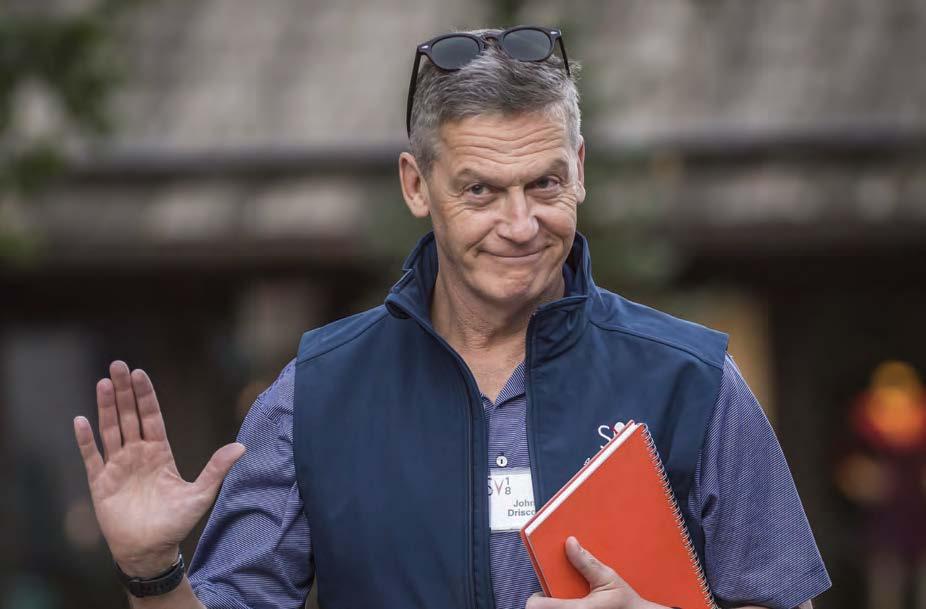
“It’s one thing to have a nurse practitioner or physician assistant who enjoys having an independent practice in a retail health location,” Pathak says. “It’s another thing for a doctor to say, ‘I’m going to practice next to where you can get your candies and sodas.’”
Walgreens is counting on VillageMD to handle recruiting doctors, establish and manage relationships with health insurers, and deal with other operational challenges of running the in-store clinics.
VillageMD CEO Tim Barry says the company hasn’t had trouble recruiting physicians for drugstore clinics, adding that many
came from large practice groups. With the addition of Summit, VillageMD will operate 680 locations, most of which are stand-alone o ces. But there’s a worsening shortage of primary care physicians in the U.S. as many medical students pursue higher-paying specialties. Data from the Association of American Medical Colleges shows that the U.S. could be missing up to 48,000 primary care physicians by 2034.
e average VillageMD clinic at a Walgreens store has about two physicians and two additional nurse practitioners or physician assistants, Barry says, and physicians treat 10 to 20 patients per day.
He says VillageMD will o er competitive salaries as it works to open more clinics in Walgreens stores, but won’t disclose average pay for doctors at the clinics. He says another selling point for
physicians is the opportunity to work in a value-based care model that rewards them for providing high-quality care, not volume.
“Our doctors—because of their demonstration of better outcomes—generally make more at Village than they make wherever they were prior,” Barry says.
SPECIALISTS
Another challenge for Walgreens and VillageMD will be navigating specialist relationships with external health care providers. Barry says that while VillageMD employs some specialists at its more than 120 stand-alone locations, the co-located Walgreens clinics rarely have specialists. at requires VillageMD to set up specialist relationships with nearby external health care providers, where Village physicians can refer patients.
“We end up working pretty tightly with the specialists in our communities,” Barry says. “ e bene t of our model is that we’re recruiting doctors to Village who have long-standing tenure in their various markets. ey know the other specialists pretty well and there’s a healthy degree of respect between the entities.”
But if Walgreens clinics have to refer patients back into the traditional health system for more advanced conditions, their relationship with the patients could weaken, according to Ray.
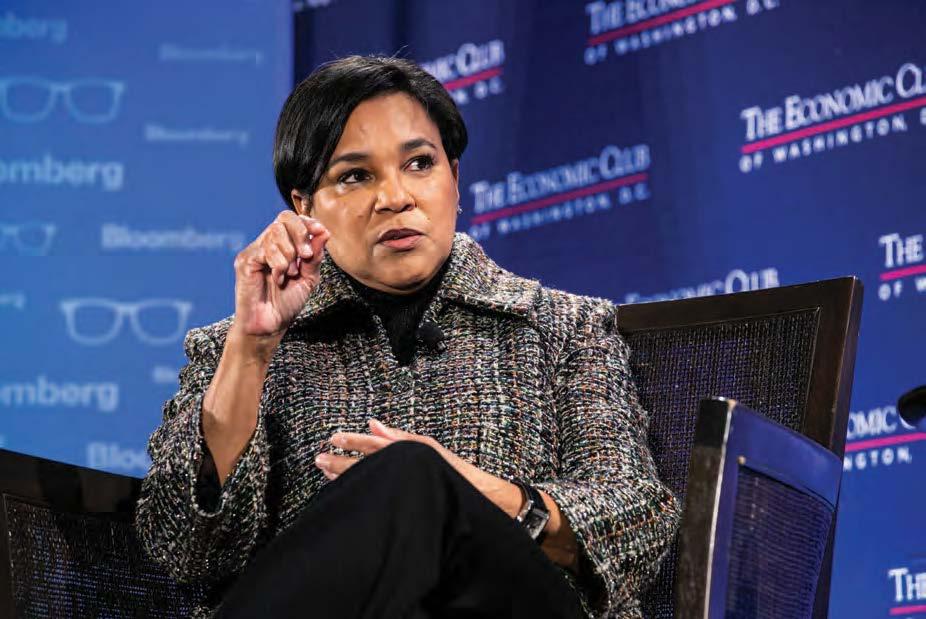
“If I have a fairly good relationship with my doctor at a retail site but then I have some new condition that I don’t feel they’re quite (quali ed) to understand, that’s a reason not to go back,” he says.
Additionally, in some cases, external specialists could work for health systems that compete with VillageMD for primary care.
To attract patients, Walgreens clinics will have to be covered by major health insurance networks. Otherwise, patients would have to pay for care out of pocket, which they don’t want to do. Becoming an in-network provider requires negotiating with insurance companies on a state-by-state and plan-by-plan basis. To get in, providers often have to agree to accept less compensation for their services, pinching pro t margins.
In an email, VillageMD said its clinics accept Medicare and are in-network for some major insurance plans, including Cigna, UnitedHealthcare and Blue Cross.
e nal and most complex task for Walgreens is the need to integrate all of its moving parts—from VillageMD to CareCentrix and Shields to Summit—into a coherent whole that works synergistically, funneling business between its various components to generate more revenue than each would get individually. Integrating acquisitions is always di cult, particularly when deals take acquirers into new markets, as Walgreens’ health care acquisitions do.
Another wrinkle is that health insurance giant Cigna is now part of the equation after its Evernorth health services unit invested alongside Walgreens in VillageMD’s $9 billion Summit deal. In a statement, Evernorth said it will provide VillageMD patients and physicians with various additional “specialty care capabilities,” like chronic condition management and behavioral physicians, as well as “real-time data and clinical insights.” Evernorth’s $2.7 billion contribution gave it a minority stake in VillageMD. Walgreens’ percentage stake fell to 52% from 63%, even as it put $3.5 billion into the deal. Now the venture will have to balance the interests of all three companies, which may not always be in harmony.
But with so much invested, there’s no turning back for Walgreens.
“ ey’re making really, really big bets,” Gordon says. “ is transformation has to work.”
CRAIN’S CHICAGO BUSINESS • DECE M BER 19, 2022 31
EDITORIAL 312-649-5200 CUSTOMER SERVICE 877-812-1590 ADVERTISING 312-649-5492 CLASSIFIED 312-659-0076 REPRINTS 212-210-0707 editor@chicagobusiness.com Vol. 45, No. 50 – Crain’s Chicago Business (ISSN 0149-6956) is published weekly, except for the rst week of July and the last week of December, at 130 E Randolph St., Suite 3200, Chicago, IL 60601.$3.50 a copy, $169 a year Outside the United States, add $50 a year for surface mail.Periodicals postage paid at Chicago, Ill Postmaster: Send address changes to Crain’s Chicago Business, 1155 Gratiot Ave , Detroit, MI 48207 Four weeks’ notice required for change of address. © Entire contents copyright 2022 by Crain Communications Inc. All rights reserved. HOW TO CONTACT CRAIN’S CHICAGO BUSINESS
John Driscoll, president of Walgreens’ health care segment
BLOOMBERG
Walgreens CEO Roz Brewer
BLOOMBERG
The diversity of the people and neighborhoods are the heartbeat of the Chicago region. United Way works to ensure every person has equitable access to opportunities and neighborhoods can thrive. With your support, we can invest in continue d progress and create a Chicago region where every child has better access to quality education, communities are safer, our neighbors are healthier, incomes increase, and our region prospers.

Now is the time to LIVE UNITED and build a stronger, more equitable Chicago region. Join us at LIVEUNITEDchicago.org




























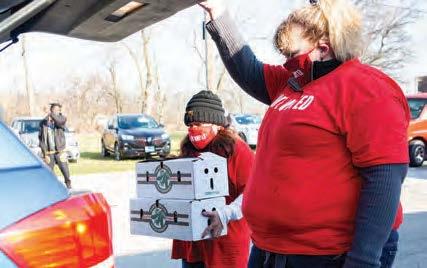








































































































 BY KATHERINE DAVIS
BY KATHERINE DAVIS










































































































 COLLECTIVE EFFORTS
COLLECTIVE EFFORTS
















































































































